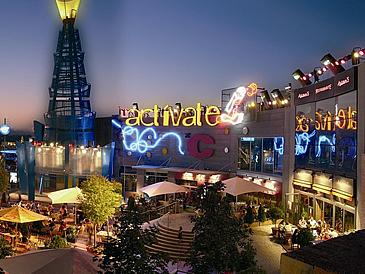Day 1: Friday - September the 3rd
Except for Canada and two weeks in Cuba I have never travelled out of the United States. I had flirted with the idea of going to Europe more than once: Why not a cycling trip across Greece? How about hiking the Dolomites in Northern Italy? Maybe exploring the beaches and mountains of Viana do Castelo, Portugal would be fun. But, it never happened. It just seemed like too big of a jump. Too much trouble. Too expensive. Too long on an airplane. Too difficult dealing with the lingos. Blah, blah, blah.
But, now that I had friends living in Segovia I had fewer excuses and more motivation to make that jump.
And, when Jeff said "All you have to do is get off the plane and we will do the rest", that clinched it! So, back in March I bought a round trip ticket to Madrid. I was now committed. I would make the jump.
The first leg of my flight was from Pittsburgh to DC. Normally I fly early and end up leaving Morgantown at the crack of dawn. But, this was to be a night flight and we rolled into the Pitt airport around 3:00pm where Betsy dropped me curbside. Much smooching and hugging ensued and then Betsy drove off. I was on my way.
NOTE: Jeff provided me with much of the specific info for the captions below for which I am very grateful. My note taking was spotty at best and there was just too much for my pea sized brain to remember. Thanks Jeff!!
And, as always, thanks to Betsy, my ever lovin' wife, for her proof reading.
My comments are formatted like this to make it easier to know who is saying what.
Click on the photos below for a larger image.

Meet Andy Warhol. Andy was a Pittsburgh native and the airport has installed a shrine for him.
I first met Andy via the Velvet Underground - a band he managed in the mid-60's. Back then I cared less about Andy and more about Nico.
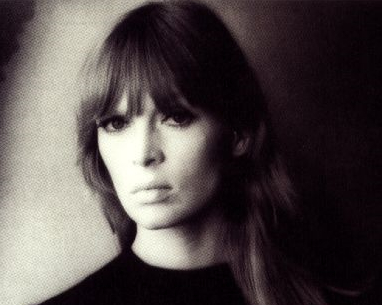 Nico, singer for the Velvet Underground.
Nico, singer for the Velvet Underground.

Some of Andy's work.


Tranny Andy - self portrait.

Here's something I'm not used to seeing - tarmac. Been a while since I disembarked in this manner.

Now at Dulles, I made my way to the gate and waited with the rest of the passengers.
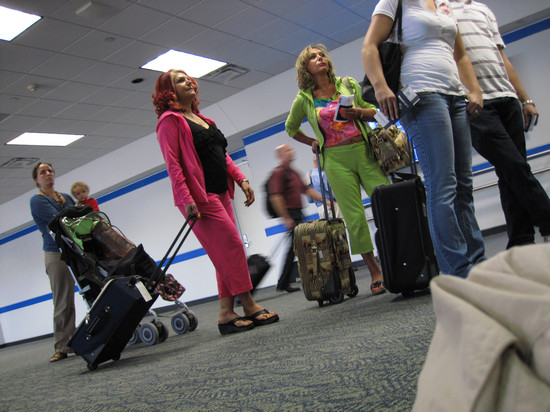
Colorful!

Meet Eden, my chatty neighbor on the 7 hour flight to Madrid. Actually she slept little and spent most of the flight watching the in-house movies. She was from Portland and taking a 30 day vacation before she started grad school.
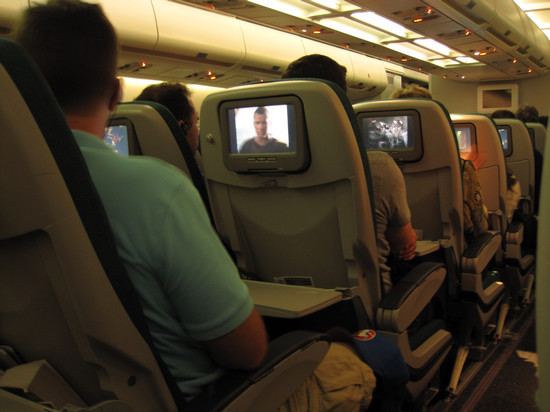
For flying, this was pretty luxurious.

The last airline provided meal I had on a plane was in a brown bag and contained a bagel and cream cheese. The pasta was good, but I was sorry they were out of the chicken with "a light curry sauce".

My landing card. Along with all the other details I needed to know Jeff also gave me the heads up about filling this out and provided me with the local info which was required.

My first look at the Madrid airport. It is 7am and still pretty dark.
Jeff had warned me it would be a long walk from the terminal to the baggage claim area. He wasn't kidding. After what seemed like a mile of corridor and several sets of steps I arrived at Baggage Claim. It was here Jeff suggested I change my USD to Euros. I would need to do this at some point and it would be a good way to spend my time while waiting for the luggage.
At the time the exchange rate was around 1:1.35. It is still about the same as of this writing. I got my bag and went through the "green" customs portal. Jeff had given me all the details about this process as well which really helped me to feel I knew what was going on and what I needed to do. When I got through customs Jeff was there as promised and we started the walk through the ramada covered parking area to the car.
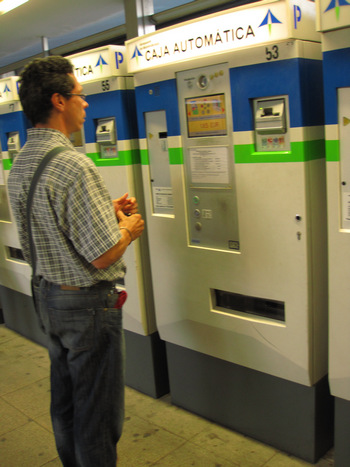
Paying for parking at the aeropuerto. "Caja Automatica" = Automatic Checkout.

Heading into the city via Avenida de América.
Jeff had promised me a "typical Spanish breakfast" and tour of Madrid when I arrived and we were now on our way.
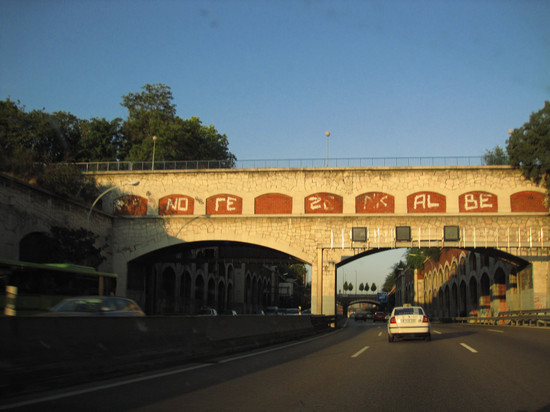
This was the first of many examples of masonry and stonework structures I was to see on this trip. Although little more than a working street bridge, the attention to details warrants a closer look.
But of course, there is always someone out there who needs to make a statement. Whoever left this graffitti had real cojones!
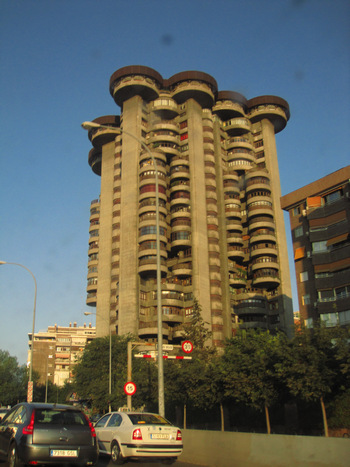
This Las Torres Blancas (ca. 1961), except that there is only one tower and it's grey!
The so called "White Towers" is 23 stories tall and a famous Madrid landmark. The color in the photo above is slightly more brown than the actual appearance.
This apartment building, built between 1964 and 1969, is considered the best example of Spanish organicismo of the time, and for many, is one of the greatest achievements of this style can be found in the world.
It is a masterpiece of Francisco Javier Saenz de Oíza, designed in collaboration with John Daniel and Rafael Moneo Fullaondo, then a member of the team's architect. The achievement is a living example of collaboration between Saenz de Oíza and construction Huarte (now merged OHL), also drafted in another landmark building in the city of Madrid, BBVA Tower on Paseo de la Castellana, opened in 1981 . Both were enormously influential achievements in the architecture of the city during these two decades and have the admiration and recognition by the international community of architects.
Source: WikiArquitectura - Google Translation
Madrid has a population of over 3 million and has an imposing skyline and quite a few sky scrapers with some very unique buildings such as the Puerta de Europa (KIO Towers).
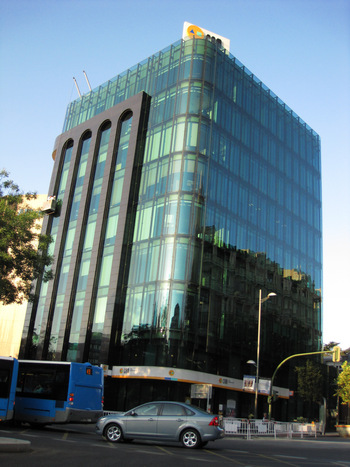
CAM (Caja de Ahorros bel Mediterráneo) building on the Paseo de la Castellana
Caja de Ahorros bel Mediterráneo, Caja Mediterráneo, or CAM is a savings bank in Spain. CAM is the result of integration at different stages of 29 financial institutions, the oldest of which traces its origins to 1875.[1] As of December 31, 2007, CAM is the 4th largest Spanish savings bank in terms of customer loans and deposits,[2] and the 3rd largest in the market share and the number of offices.
Source: WikiPedia
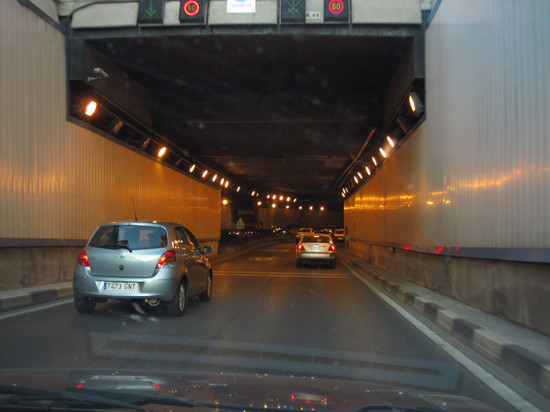
Heading into one of the many tunnels in Madrid.
I was amazed at the number and the lengths of the tunnels we saw on our tour! We made our way to the University where we parked in a large, under utilized underground parking garage. Next we would find the Metro station and head further into Madrid.

The cruelly vandalized sculpture by Anna Vaughn Hyatt Huntington is called The Torch Bearers.
In 1955 Anna Hyatt Huntington and her husband donated her sculpture The Torch Bearers to the University of Madrid. The work symbolizes the passing of the torch of civilization from one generation to the next. The version seen at Stevens Institute of Technology in Hoboken, New Jersey is one of three replicas. It was donated to Stevens in 1964, where it joined the colleges growing collection of paintings and sculpture. Two other replicas of The Torch Bearers are located at the Museum of Art, Science, and Industry in Bridgeport, Connecticut and the Chrysler Museum in Norfolk, Virginia.
I agree with the Mayor of Las Vegas!
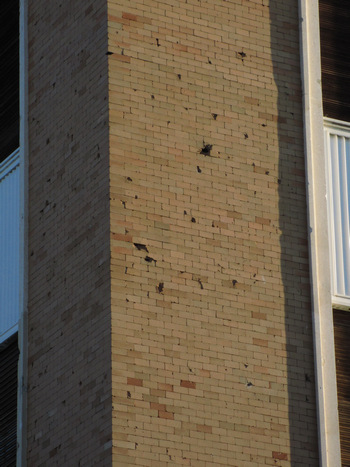
This is at Ciudad Universitaria, which was being built at the outbreak of the Spanish Civil War (the holes in the bricks are likely due to rifle/machine gun fire).
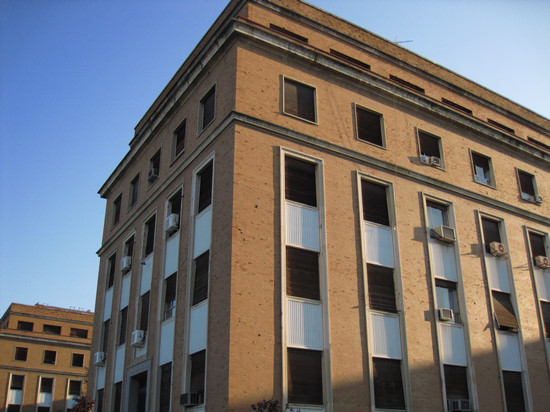
Note the pock marks and divots in the face of the building. Scary.
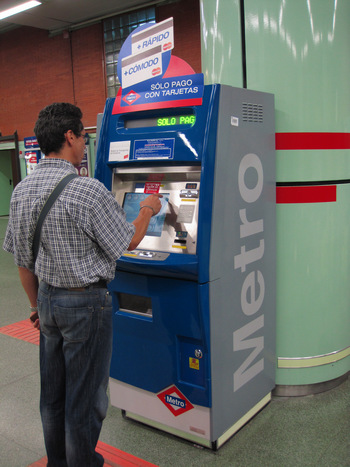
Here, Jeff buys us our Metro tickets to downtown and our breakfast destination.

The Ciudad Universitaria Station-Metro de Madrid (one of the best--and cheapest--in the world!)
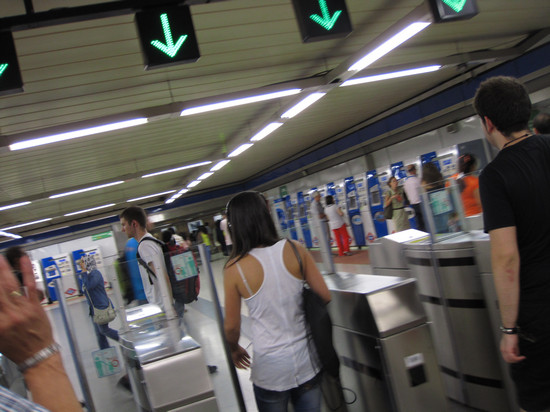
Exiting the metro at Moncloa station.
Moncloa Bus Station, or Estación de Autobuses de Moncloa, is located on the western edge of Madrid, about 10 minutes walk along Calle de la Princesa from Plaza de España. Just north of the station stands the impressive and imposing Arch of Victory, Arco de la Victoria, sometimes wrongly called Puerta de la Moncloa.
Source: Copyright © GoMadrid.com. 2010
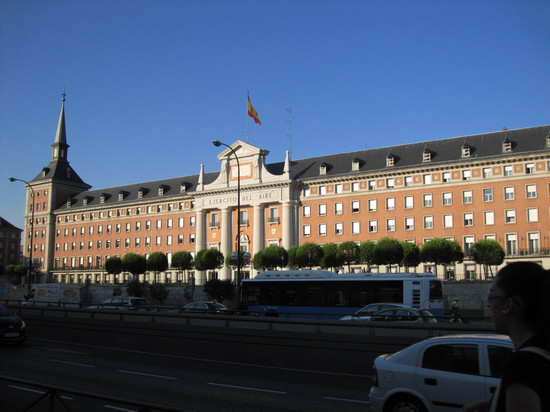
The headquarters for the Spanish air force.
That's a lot of windows! "Ejercito bel Aire" = Army Air
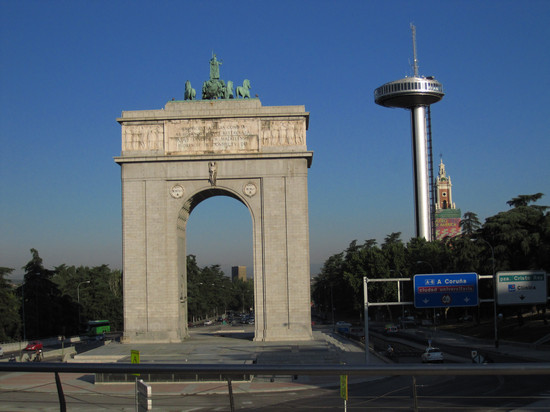
The Victory Arch at Moncloa (with that ungodly ugly spire thing, too).
A Franco Legacy
The Arch looks older than it really is. Dictator Franco had it built in 1956 as a tribute to his Nationalist army who defeated the republicans during the Spanish civil war (1936-1939). The Arco de la Victoria is also known as the Puerta de Moncloa or Moncloa Gate, a name preferred by those who don't want to be reminded of the late dictator.
The 39m/128ft high imposing arch is topped by a statue of a four-horse chariot. Franco used to drive along this route on a regular basis traveling to Madrid's city center from his main residence, the El Pardo Palace.
Lookout
The Arco de la Victoria is not open to visitors, although there is a room inside the arch with a model of the nearby university as well as the plans for the arch.
Not far from the arch is the Mirador bel Faro, also known as the Faro de Moncloa or Faro de Madrid. This futuristic looking tower was built in 1992 as a communication center. Unfortunately the 92m / 300ft tower's observatory closed in 2005.
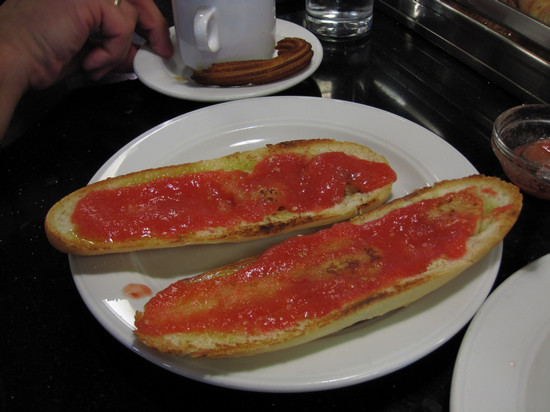
Finally - breakfast!!
The "Andalusian breakfast" at the Van Gogh Café (toasted bread with olive oil and tomato sauce)
"This consists (Andalusian breakfast) of "tostada con aceite". "Tostada" is toasted bread, which consists of an elongated bun called a "pitufo" that has a crunchy exterior. Olive oil is sprinkled over the toast. Many times the toast is enhanced with sliced tomatoes, and maybe a little ham. The toast is usually accompanied with coffee." - 2010 TripAdvisor.
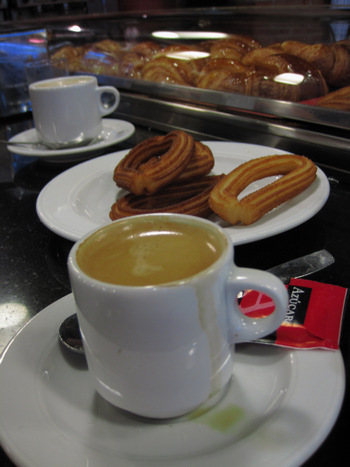
It can't be breakfast with out churros and café con leche
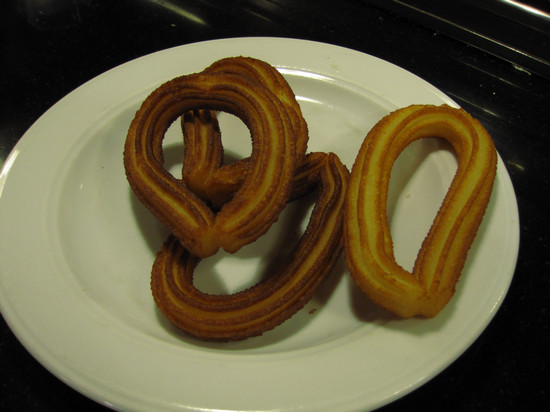
Churros are fried pastry dough similar to a donut. Great for dipping in coffee or hot chocolate. Tasty!
As I was to find out later in the trip there is a larger version of the Churro called a Porras.
Preparation
Churros are typically fried until they become crunchy, and then are sprinkled with sugar. The surface of a churro is ridged due to having been piped from a churrera, a syringe with a star-shaped nozzle. Churros are generally prisms in shape, and may be straight, curled or spirally twisted.History
After the Portuguese sailed for the Orient and returned from ancient China to Portugal, they brought along with them new culinary techniques, including modifying the dough for Youzagwei also known as You tiao in Northern China, for Portugal. However, they modified it by introducing a star design because they did not learn the Chinese skill of "pulling" the dough (the Chinese Emperor made it a crime with capital punishment to share knowledge with foreigners). As a result, the churros is not "pulled" but pushed out through a star-shaped cutter.Source: WikiPedia
Now, fueled up, we are ready for our walking tour of downtown Madrid.
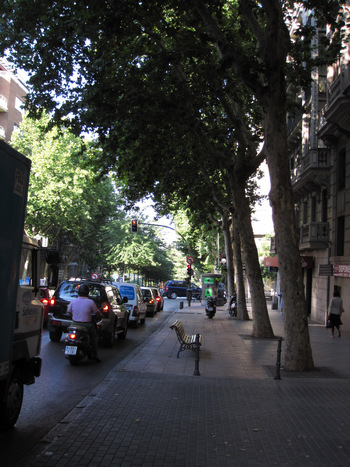
Walking down the Marqués de Urquijo street.
I really enjoyed all the tree lined streets. I think these were are Sycamore Maple (Acer pseudoplatanus). Sycamore is known as the Plane tree, although it is not a member of the Platanus genus.
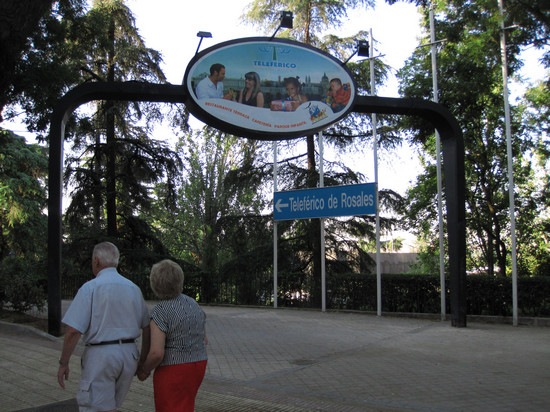
Entrance to the sky tram (teleférico).
This cable car spans some of Casa de Campo.
Jeff and I had talked about taking the tram when we were planning my visit. But, it will have to wait until next time.
If you want to see Madrid from a bird's eye view, take the cable car ("el Teleférico") that was originally built as part of the Parque de Atracciones amusement park. The journey starts on the Paseo bel Pintor Rosales street, near the Argüelles Metro station, and takes you over the River Manzanares and into the Casa de Campo park.
The cable car carries you above the city's parks and the Manzanares River in the distance, as a recorded commentary describes what you are looking at. You'll be seeing attractions such as the Plaza de España and the Egyptian temple of Debod from a completely different perspective, as well as taking photos from several other angles.
Source: Copyright © GoMadrid.com. 2010
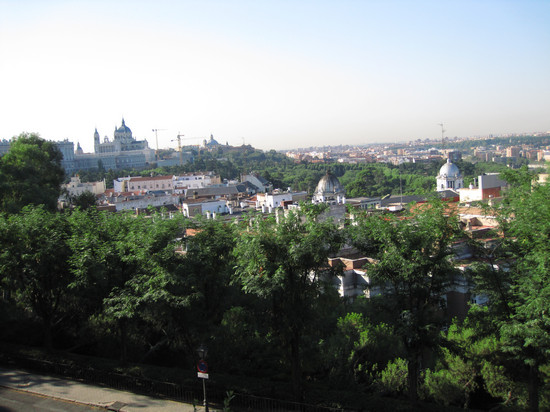
View from the " Parque de la Montaña" (note the Almudena cathedral in at top left.
Mountain Park:
Después de la guerra se barajaron diversas ideas para aprovechar el solar, como por ejemplo, la edificación de la Casa de la Falange o la construcción de un nuevo ministerio.
After the war, various ideas were considered to build the site, for example, the building of the House of the Falange and the construction of a new ministry.
Ningún proyecto salió adelante y el solar fue finalmente cedido al Ayuntamiento de Madrid para que lo destinase a jardín público.
Neither project went ahead and the site was ultimately given to the City of Madrid to that used for public garden.El parque del Cuartel de la Montaña fue inaugurado el 20 de julio de 1972 , y en recuerdo de los hombres que murieron en su defensa se erigió un monumento (en 1972 todavía estaba en el poder Francisco Franco ), realizado por Joaquín Vaquero Turcios y compuesto por una figura de bronce que representa el cuerpo de un hombre mutilado, colocada en el centro de un paredón construido en forma de sacos terreros.
The park's headquarters on the Mount was opened on July 20 of 1972 , and in memory of the men who died in defense a monument was erected (in 1972 was still in power, Francisco Franco ), by Joaquin Vaquero Turcios and composite by a bronze figure representing the body of a maimed man, placed in the center of a wall built in the form of sandbags.El mismo día también fue inaugurado el Templo de Debod en el mismo parque, situado en el solar que ocupó el cuartel.
The same day was also inauguratedSource: WikiPedia and Google Translation
Santa María la Real de La Almudena is a Catholic cathedral in Madrid.
When the capital of Spain was transferred from Toledo to Madrid in 1561, the seat of the Church in Spain remained in Toledo; so the new capital – unusually for a Catholic country – had no cathedral. Plans were discussed as early as the 16th century to build a cathedral in Madrid dedicated to the Virgin of Almudena, but construction did not begin until 1879.
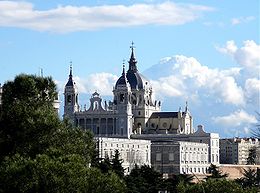
Francisco de Cubas, the Marquis of Cubas, designed and directed the construction in a Gothic revival style. Construction ceased completely during the Spanish Civil War, and the project was abandoned until 1950, when Fernando Chueca Goitia adapted the plans of de Cubas to a baroque exterior to match the grey and white façade of the Palacio Real, which stands directly opposite. The cathedral was not completed until 1993, when it was consecrated by Pope John Paul II. On May 22, 2004, the marriage of Felipe, Prince of Asturias to Letizia Ortiz Rocasolano (known thereafter as Letizia, Princess of Asturias) took place at the cathedral.
Source: WikiPedia
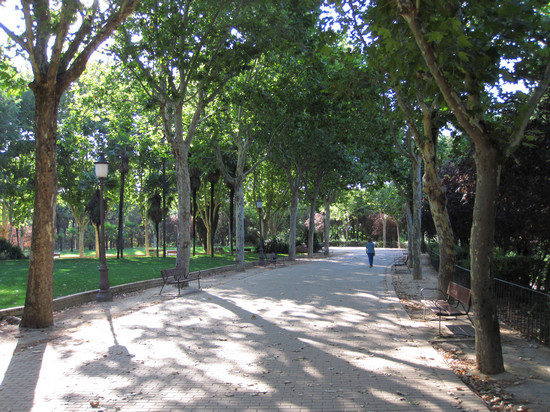
See?! There are trees in Madrid! More of those lovely Sycamores.
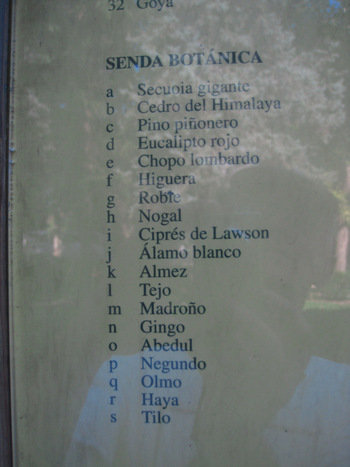
List of trees along the Park's "Botanical Path".
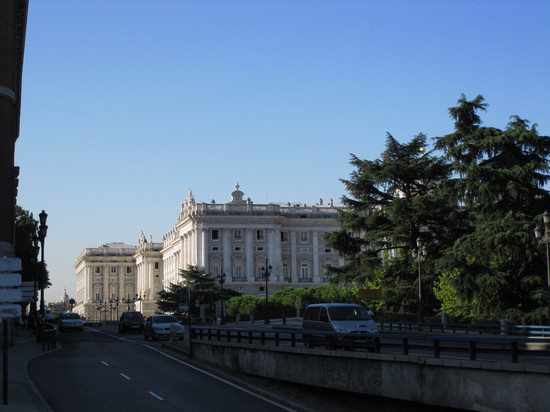
Walking toward the Royal Palace of Madrid.
The Palacio Real de Madrid (English: The Royal Palace of Madrid), also known as the Palacio de Oriente (English: The Orient Palace, or Far East Palace), is the official residence of the King of Spain in the city of Madrid, but it is only used for state ceremonies. King Juan Carlos and the Royal Family do not reside in the palace, choosing instead the more modest Palacio de la Zarzuela on the outskirts of Madrid. The palace is owned by the Spanish State and administered by the Patrimonio Nacional, a public agency of the Ministry of the Presidency. The palace is located on Bailén Street, in the Western part of downtown Madrid, East of the Manzanares River, and is accessible from the Ópera metro station. The palace is partially open to public, except when it is being used for official business.
The site of the palace dates from a 10th-century fortress, called mayrit, constructed as an outpost by Mohammed I, Emir of Córdoba and inherited after 1036 by the independent Moorish Taifa of Toledo. After Madrid fell to Alfonso VI of Castile in 1085, the edifice was only rarely used by the kings of Castile. In 1329, King Alfonso XI of Castile convoked the cortes of Madrid for the first time. Philip II moved his court to Madrid in 1561
Source: WikiPedia
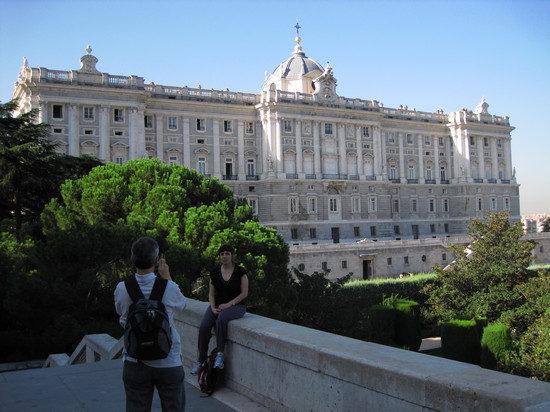
Side view of the Royal Palace.
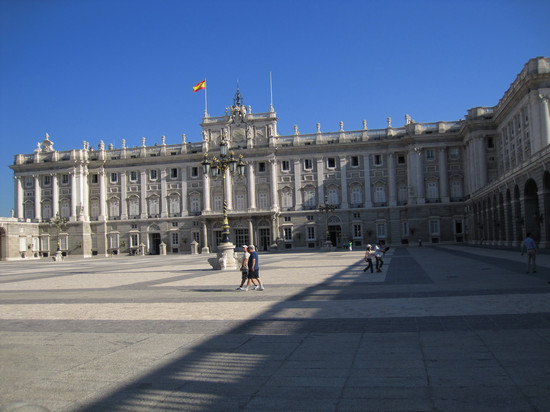
The "Patio de Armas" of the Royal Palace.
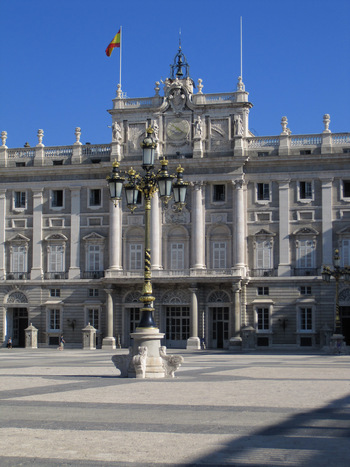
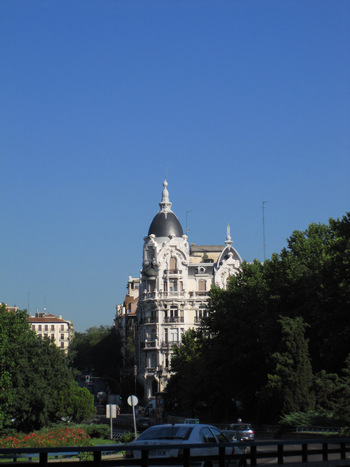
View of Ferraz street.
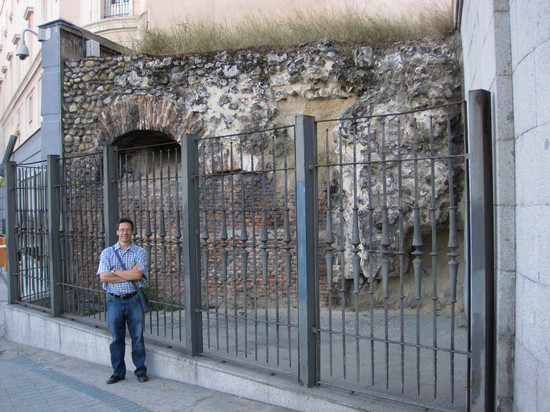
Mike's personal tour guide beside one of the city walls (15th/16th century), adjacent the Senate Building on Bailén street.
Madrid's City Walls
Dating from the 9th century, these elaborate fortifications were built to protect the Moorish settlement of Magerit or Mayrit that moved to the left bank of the Manzanares River. They stand today as reminders of the first city limits.They originally surrounded an area of around 4 hectares, around a small castle or fort located where today's Royal Palace stands. Other palaces and castles were also built over the following centuries, until the present-day's marvelous Eastern Palace or Palacio bel Oriente as the Royal Palace is known.
Other parts of the wall also date from post-Moorish times, added in the 12th and 13th centuries by the Christian settlers. The ruins of one of the corner towers, the Torre de Narigues, can also be seen at Calle Mayor number 83.
Source: Copyright © GoMadrid.com. 2010
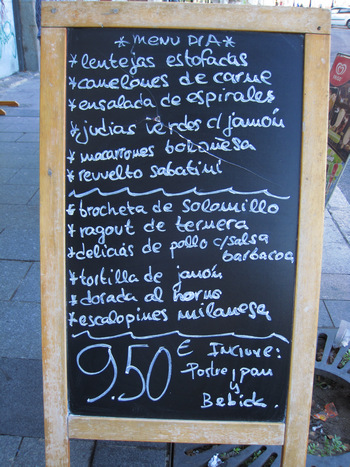
The daily special for only 9,50€ at the Sabatini restaurant (1st course: lentils, canelones, pasta salad, green beans, maccheronis with meat sauce, scrambled eggs "sabatini"; 2nd course: sirloin brochette, veal ragout, chicken in bbq sauce, jam omelette, baked bream, fried pork chops a la milanesa; plus bread, dessert and drink).
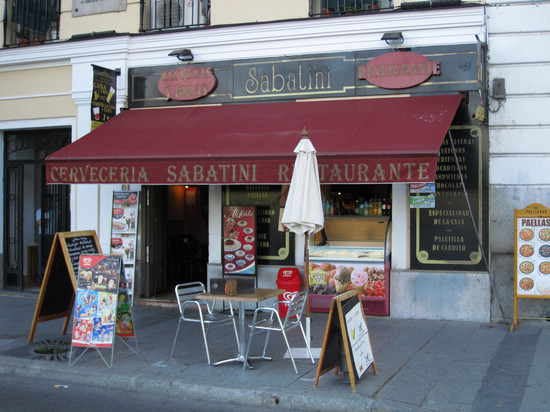
The Sabatini. It is directly across the street from the Royal Palace.
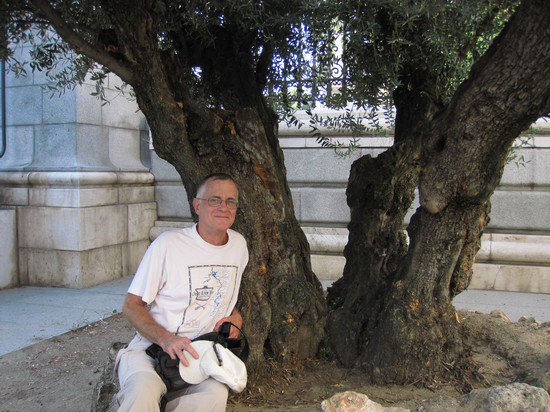
An American tourist with olive tree.
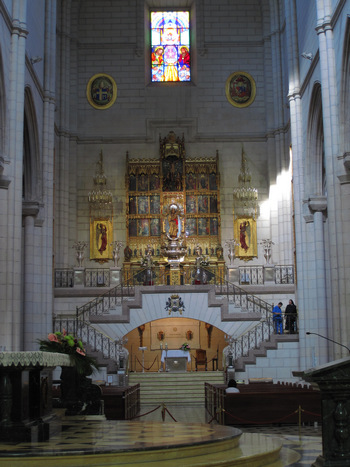
Inside the Almudena Cathedral (Mike said he took this pic as a reminder of his catholic childhood).
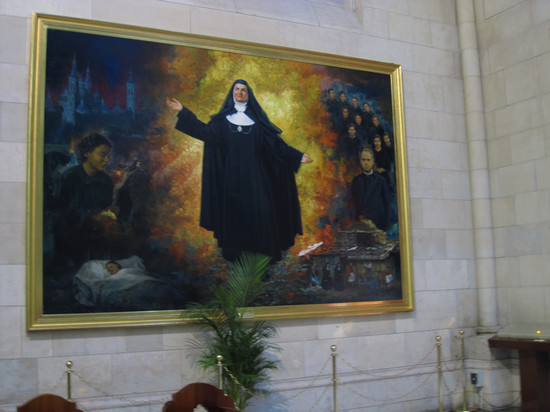
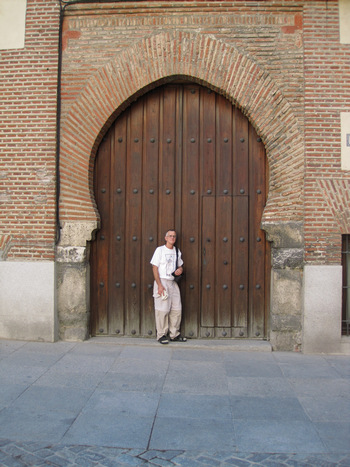
The first doorway pic (of many), at the Plaza de la Villa - note the mudéjar style
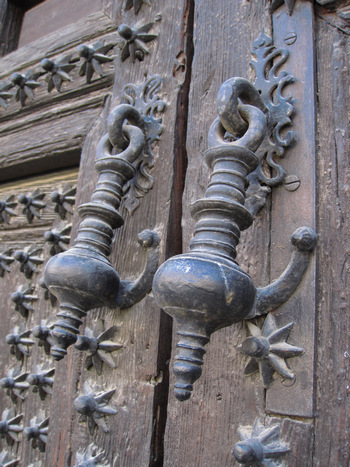
What knockers!
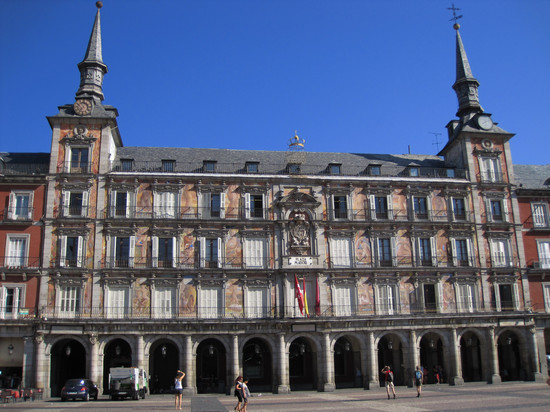
Plaza Mayor (Casa de la Panadería).
"Plaza Mayor" means "main square" or "city square". It may seem obvious to some, but it was not to me.
It was a phrase I was to hear repeatedly during my visit. -mb
The Plaza Mayor was built during the Habsburg period and is a central plaza in the city of Madrid, Spain. It is located only a few blocks away from another famous plaza, the Puerta bel Sol. The Plaza Mayor is rectangular in shape, measuring 129 by 94 meters, and is surrounded by three-story residential buildings having 237 balconies facing the Plaza. It has a total of nine entrance ways. The Casa de la Panadería, serving municipal and cultural functions, dominates the Plaza Mayor.Source: WikiPedia
The Casa de la Panadería is a municipal and cultural building on the north side of the Plaza Mayor in Madrid. It is four stories high, the ground floor comprising porticos and the top floor in the form of an attic, with its sides crowned by angular towers.
The Casa de la Panadería (Bakery House) was erected during the construction of the Plaza Mayor. Juan Gómez de Mora was in charge of its construction, which was completed in 1619. After the second burning of the plaza in 1670, the building was rebuilt by Tomás Román, who commissioned painters Claudio Coello and José Jiménez Donoso to decorate the interior and the frescoes on the facade. After the third burning of the plaza in 1790, the surviving Casa de la Panadería served as a reference for Juan de Villanueva's reconstruction of the rest of the plaza.
La Casa de la Panadería has suffered several remodelings since then, most notably that carried out by Joaquín María de la Vega in 1880.
Source: WikiPedia
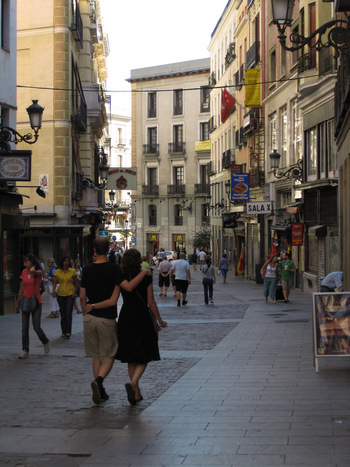
This is La Calle de las Postas --just off Plaza Mayor-- has just about everything a tourist could want: Museo del Jamón, McDonald's and a Sala X (old porn movie house)!!!
By now, all this walking and taking in the sights had made us a bit hungry. Fortunately we were not far from the original "Ham Heaven". -mb
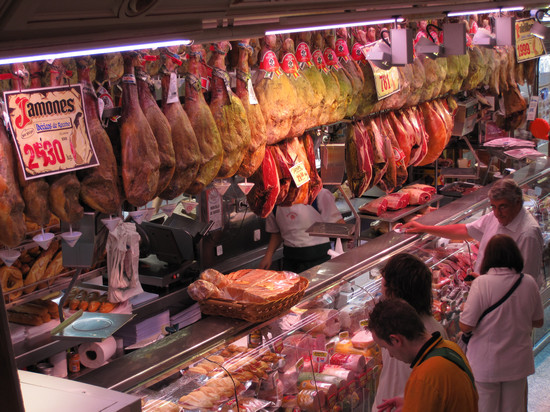
Inside the Museo del Jamón (it's a restaurant, not a museum).
The Museo del Jamón is an institution in Madrid. The Museo del Jamón, like so many Spanish bars, has a huge number of hams dangling from its bars - and a wonderful selection it is - from the standard to the expensive (like Pata Negra) and from different provinces in Spain. They also offer good menus and tapas. For people who would like to know the process of curing the ham, take a look at their website (in the section 'Proceso de Elaboración'). This site contains all their locations in Madrid and useful pictures (under 'Menus') to let you know what the dishes are.
Source: www.madaboutmadrid.com
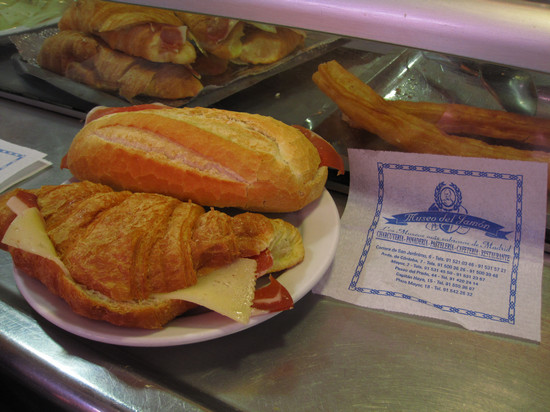
More breakfast (croissant mixto--ham and cheese) and bocadillo de jamón)
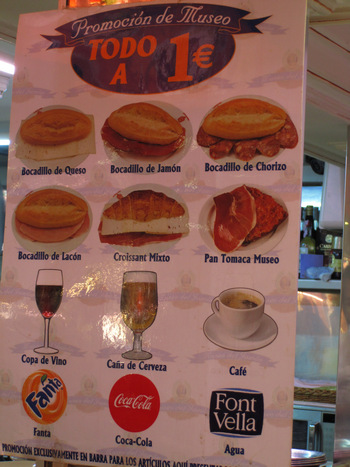
The special (1€!)
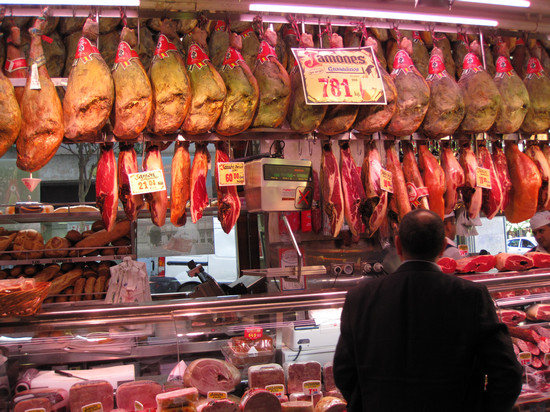
Jamones hanging in the "museum".
One of the producers of Jamons is " Jamones Granadinos". Take a look at their website and you will see how seriously the Spanish take their ham!
Jamón serrano (literally mountain ham) is a type of jamón (dry-cured Spanish ham), which is generally served raw in thin slices, or ocassionaly, diced. The French jambon bayonne and Italian prosciutto crudo are similar. A foreleg prepared in the same manner is called paleta.
Fresh hams are trimmed and cleaned, then stacked and covered with salt for about two weeks in order to draw off excess moisture and preserve the meat from spoiling. The salt is then washed off and the hams are hung to dry for about six months. Finally, the hams are hung in a cool, dry place for six to eighteen months, depending on the climate, as well as the size and type of ham being cured. The drying sheds (secaderos) are usually built at higher elevations, which is why the ham is called mountain ham.
Source: WikiPedia
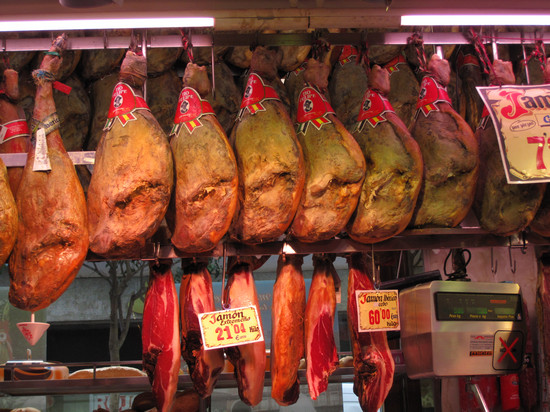
I was thrilled shitless to be here! This place is legendary as are the Jamóns. Food is one of my primary motivators for travelling and I could see already Spain was not going to let me down.
A bit of history
Since antiquity Spaniards have produced dry-cured hams. The first written references date back to the Roman Empire. From the very beginning, production of this type of ham has been uncomplicated - taking what nature provides in order to preserve and enrich pork: nothing more complex than sea salt, the correct environmental conditions, and time.Historically speaking, fresh ham was cured in mountainous areas with moderate climates that are warm and dry in the summer and cold in the winter. Mountain, or “sierra” (serrano), air favored gradual aging of the meat. This was aided by a preliminary application of sea salt.
Ham processing started during the first weeks of November, at the start of the winter. For centuries families sacrificed and butchered the pigs that they had bred and fattened domestically. This ritual is called the “matanza”; an occasion for a celebration in which all family members participated. Note that the Spanish word for "to slaughter" is sacificar – “to sacrifice” – reflecting quite a different concept of respect for the animal than the English word slaughter suggests.
The hams were initially covered in sea salt to begin the curing process. After several days, the hams were washed and then hung in curing sheds with sufficient ventilation. There the hams receive the mountain air, whose qualities vary as the seasons change.
After about a year this process yielded dry cured Serrano hams that were sufficiently cured for consumption, without any kind of additive or additional handling.
Source: © 2010, LaTienda

Click on the yummy ham to order!
Or, if you are really picky about your ham you can order this one.
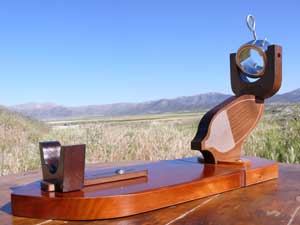
There are many kinds of ham stands. Take a look at these.
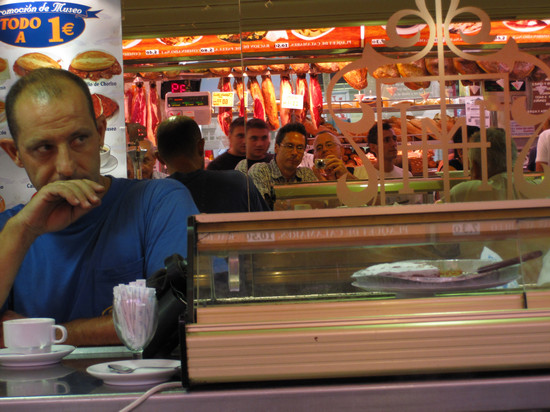
Who are those guys? (in the mirror)
Poor Jeff, look what he has to put up with! -mb
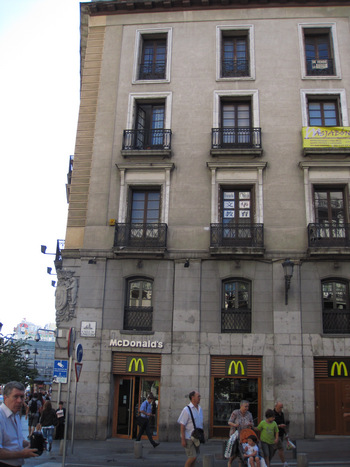
Yes, there are Mc Donalds in Spain!
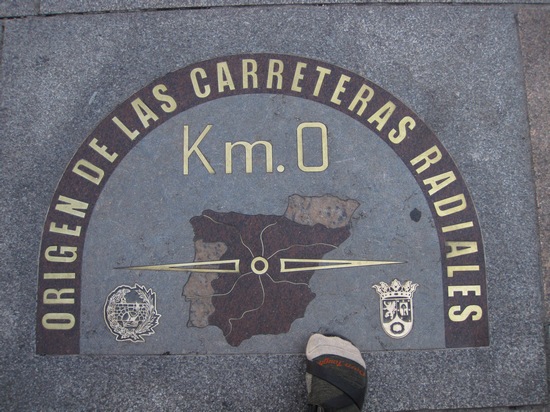
Here we are at the Zero Kilometer point at Puerta del Sol for the 6 radial highways in Spain.
This (Puerta del Sol) is Madrid's most famous and most central square, located just a short walk from the Plaza Mayor. Originally it was the site of one of the city's gates, which faced the east and was adorned with an image of the sun, hence the square's name. The square is actually almost semi-circular in shape and owes its current form to the major renovation work carried out between 1854 and 1860.
Source: Copyright © GoMadrid.com. 2010
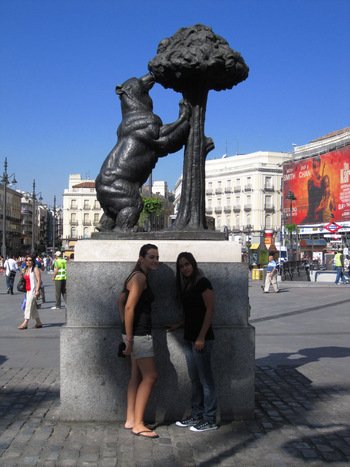
El Oso y el Madroño (symbol of Madrid).
The Bear and the Strawberry tree
Bears were once common around Madrid, and herein probably lies the origin of Madrid 's shield El Oso y el Madroño (The Bear and the Strawberry tree - a favourite morsel of bears in Spain ). The area around Madrid was known as Ursaria for some time. The Libro de Montería (Book of the Hunt by King Alfono XI states: Madrid , un buen lugar de puerco y oso ( Madrid a good place for swine and bear).Source: Iberia Nature A guide to the natural history of Spain
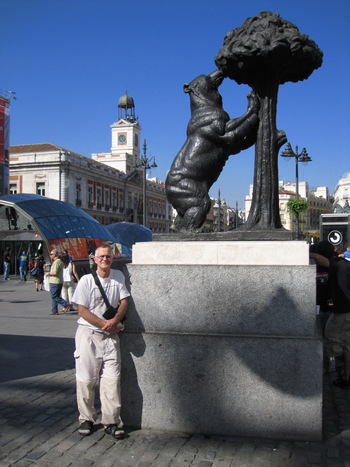
The clock tower in the background is rising from "Real Casa de Correos" (post office).
The Real Casa de Correos is a building located in the southern part of the Puerta del Sol in Madrid ( Spain ). Its construction dates from the end of the second half of the eighteenth century, and is the oldest building in the Puerta del Sol. The best known of the architecture is the clock that exists in a tower erected on the roof. This watch is the main character anniversary every year on the night of December 31 because of the chimes that mark the ritual of the twelve grapes.
Opposite the main entrance you can see a historical plaque on the Kilometer Zero (origin of the radial roads.) Despite the many roles he has owned the building at present is the seat of Presidency of the Community of Madrid . Located on the corner of Post Street, with the San Ricardo Street (named in honor of the consumptive Hospital located in the vicinity) as well as the street carts. The surrounding buildings are the Lamb House and the Royal House Relay.
Source: WikiPedia - Google Translation
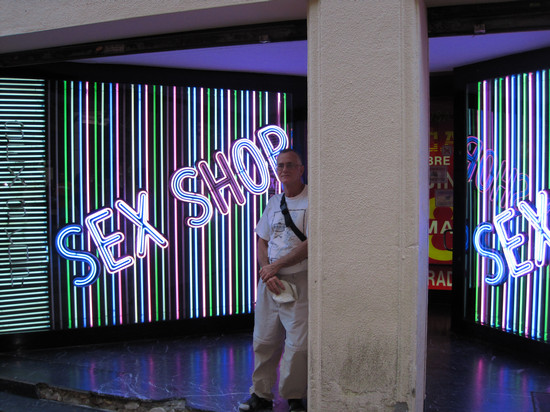
Mike coming out of the Sex Shop.
HEY!! I was shopping for Betsy. Honest...
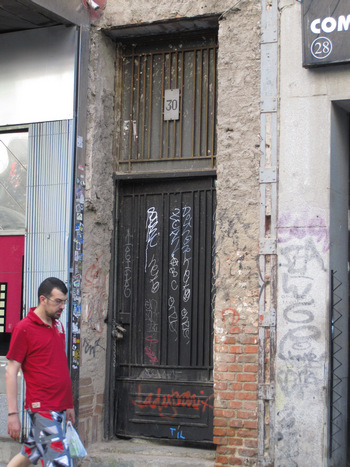
I took this photo because I thought it was an interesting mish-mash of building materials
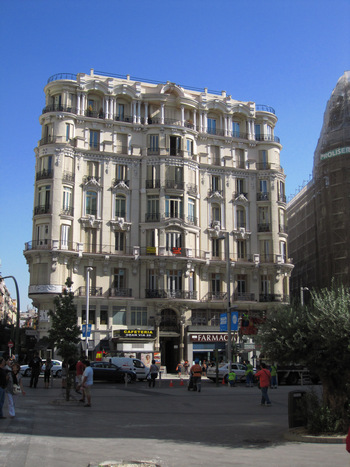
The renovated Red de San Luis (GranVía metro stop)...this plaza used to be a major stop for several bus lines, now it's gone all pedestrian.
I was really diggin' all the gorgeous buildings here. Gawking at buildings is one of my favorite pass times when I travel.
_01.jpg) Red de San Luis from WikiPedia
Red de San Luis from WikiPedia
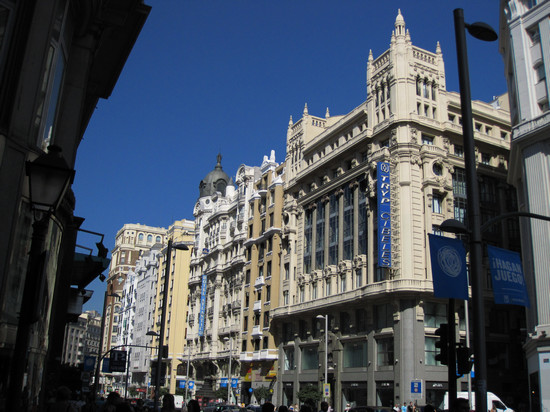
Look up the Gran Vía (rough translation "Broad Way").
Gran Vía (literally "Great Way") is an ornate and upscale shopping street located in central Madrid. It leads from Calle de Alcalá, close to Plaza de Cibeles, to Plaza de España.
The lively street is one of the city's most important shopping areas, with a large number of hotels and large movie theaters; it is also noted for the grand architecture prevalent among many of its buildings. Now, most of the theaters are being replaced by shopping malls.
It is considered a showcase of early 20th century architecture, with patterns ranging from Vienna Secession style, Plateresque, Neo-Mudéjar, Art Deco and others.
Source: WikiPedia
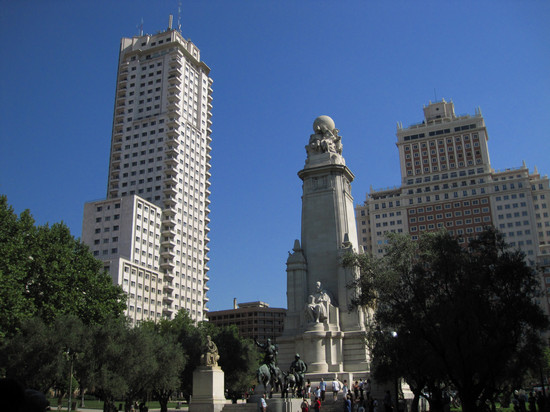
Monument to Cervantes in the Plaza de España.
Cervantes Monument
In the center of the plaza is a monument to Spanish novelist, poet and playwright Miguel de Cervantes Saavedra, designed by architects Rafael Martínez Zapatero and Pedro Muguruza and sculptor Lorenzo Coullaut Valera. Most of the monument was built between 1925 and 1930. It was finished between 1956 and 1957 by Federico Coullaut-Valera Mendigutia, the son of the original sculptor.The tower portion of the monument includes a stone sculpture of Cervantes, which overlooks bronze sculptures of Don Quixote and Sancho Panza. Next to the tower, there are two stone representations of Don Quixote's "true love", one as the simple peasant woman Aldonza Lorenzo, and one as the beautiful, imaginary Dulcinea del Toboso.
Plaza de España (or "Spain Square" in English)
A large square, and popular tourist destination, located in central Madrid, Spain, at the western end of the Gran Vía. It features a monument to Miguel de Cervantes Saavedra, and is bordered by two of Madrid's most prominent skyscrapers. Also, the Palacio Real (Royal Palace) is a short walk south from the plaza.Source: WikiPedia
Jeff, knowing my interest in motorized vehicle and pedestrian co-existence in urban areas now led me to an area which has recently been transformed from a traffic/pedestrian nightmare to a beautiful park-like area complete with urban forest. So, now we move from the old, to the very, very new.
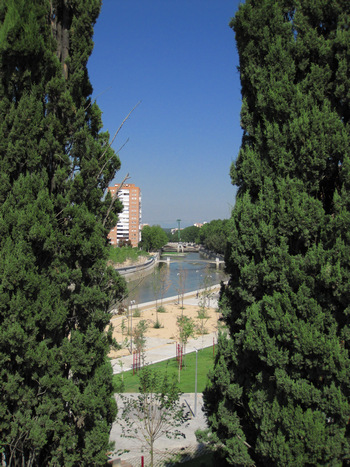
Looking at the Manzanares River (the new--and still under construction Madrid Río ).
I was stunned by the number and density of the trees planted here. This is all new and is on top of a four lane highway! When complete there will be over 3 square miles of new green space with over 26,000 newly planted trees. Now that, is an urban forest!!
There is a PDF of the plan here.
The Madrid Rio Project will give a great linear park from El Pardo to Getafe, which includes a new beach near to El Matadero. This Special plan, that affects 8,200,000 square meters along six districts: Moncloa, Centro, Arganzuela, Latina, Carabanchel and Usera.
The project is developed around five main axes: The river redevelopment, The Pine Park, the growing and creation of green zones, the fun and sports axis, and the urban planning of the zone.
To avoid the river to be a new barrier, 23 pedestrian bridges will be built, specially between Vicente Calderón Stadium and Praga’s bridge, connecting the beach, the Arganzuela Park, and the cultural venues of El Matadero and Fruit Market with the Pine Park. As well, other historical bridges will be recovered.
A 6 km long and 25 m wide green walk in the western bank will form the Pine Park, where will be a bicycle lane, children zones, spaces for elders and a lot of gazebos and covered terraces.
The project includes more than 3,200,000 square meters of green zones, so the current surface will be increased in 213.000 square meters and 26,263 new trees will be planted.
Source: Urbanity.es
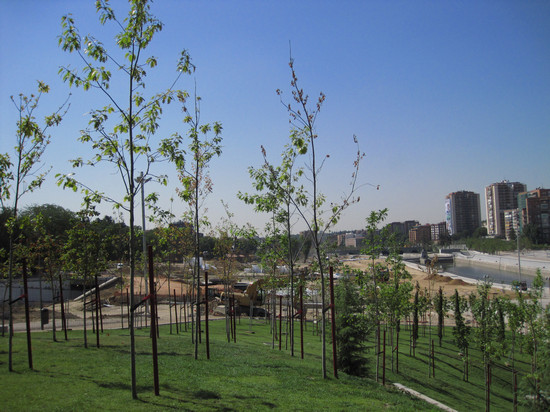
Landscaping the Rio Madrid area (this is the Puente del Rey area).
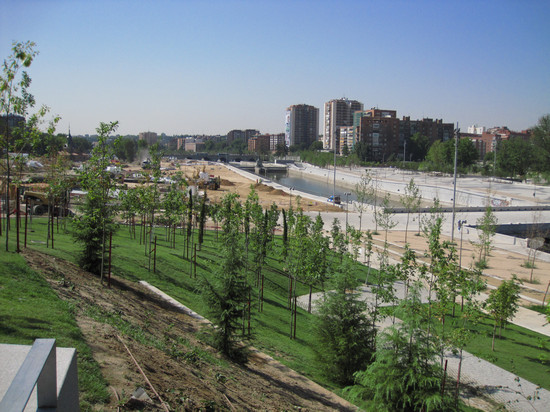
The area on the opposite side of the River is a newly constructed beach!
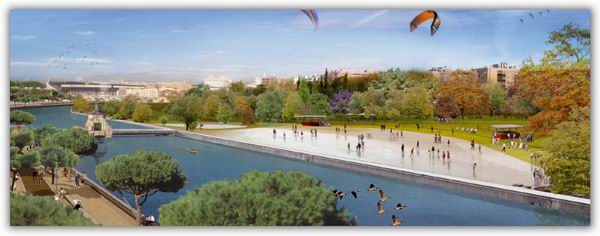
Image© GoMadrid.com
Madrid is located approximately 350 kilometres (around 220 miles, around a 4-hour drive) from the nearest beach in the region of Valencia, but by the year 2010, the Madrid beach will be a reality!
In January 2008, the Madrid Río project (el Plan Especial Madrid-Río) was unveiled by the Lord Mayor of Madrid, Alberto Ruíz Gallardón.
Due to the move underground of a large section of Madrid's inner ring-road, the M-30, 820 hectares along the Manzanares River will be converted into a long park, and including an urban beach, rowing lanes on the river, walks, bicycle paths, kiosks, cafés and restaurants, terraces, cultural and sports facilities, areas for pensioners and children's play areas. All this just 1.5 kilometres from the Puerta del Sol in the centre of Madrid.
Source: © GoMadrid.com
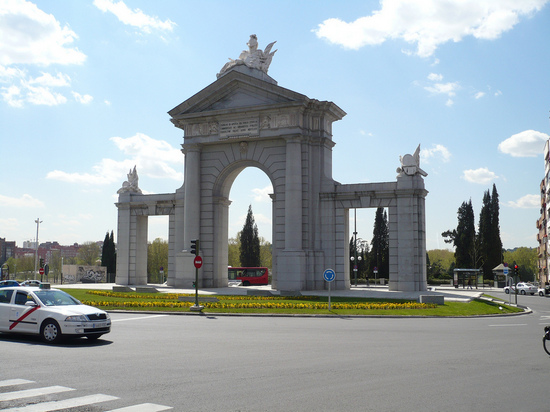
Photo Credit: WikiPedia Commons
This is Puerta de San Vicente. It is one of several gates in the city of Madrid. The original one was demolished and then later rebuilt.
In the background is the area where the above photos of the Madrid Rio project were taken.
King Carlos III also commissioned Sabatini to build the Puerta de San Vicente (Saint Vincent’s Gate) in 1775, almost at the same time as the Puerta de Alcalá. The original construction didn’t survive however, as it was dismantled in 1892 to create more space for traffic to circulate, and some of the blocks from which the monument had been constructed were used to build the monumental lampposts in Cybeles square. This idea was suggested by the municipal architect of the time López Salaberry, who also asked for permission to auction off the pillars that were not going to be reused.
The idea of rebuilding the Puerta de San Vicente was put forward on several occasions. One of the project’s great supporters was Queen María Cristina, who on several occasions expressed a desire that the gate should be rebuilt somewhere in Madrid. Much later, in 1962, the City Council approved a motion to reproduce the monument at a cost of one million pesetas (6,000 euros). The first stone was not laid however until 1994, when the Puerta de San Vicente was finally rebuilt in the Arganzuela district.
Formed by a single arch and two blind apertures, the exterior of the archway itself is decorated with two Doric columns and two pilasters in its interior. The upper cornices are original, but the lion’s head and the sculptures of coats of arms, flags and musical instruments are copies created by José Luis Parés.
On April 25, 1995 was reopened.
My memory is foggy on the details but I think it was now around 1:00. We had been on the go since 8:00 and I was running on only a few hours of sleep I managed to snatch on the flight over. But, no matter. I can sleep anytime - right!? We now needed to get back to the car and drive to Aravaca to pick up Ana, Jeff's wife. So, it was over to the metro station to catch a train which would take us back to the car.
First, we caught our breath and sat for few minutes at the station plaza. I took a few digi-snaps while Jeff had a beverage and pincho.
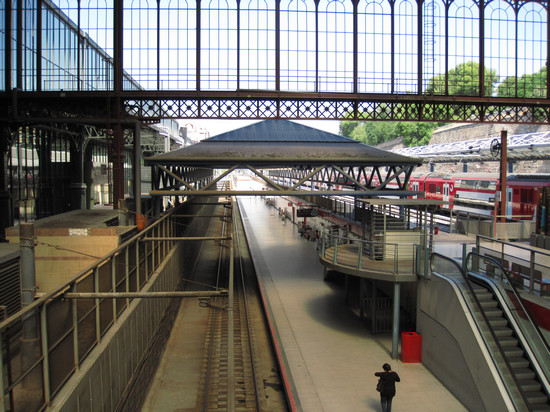
In the Príncipe Pío "Intercambiador" train/metro/bus station (note the artistic use of RR ties).
This is a beautiful old train station which has been refurbed and modernized. I wish I had taken more pictures of the gorgeous wrought iron structural members.
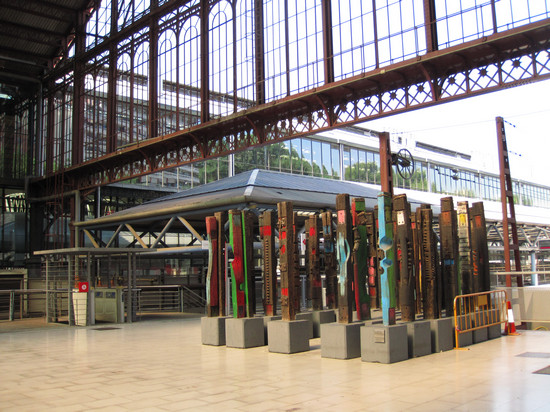
I love stuff like this! Nothing like turning construction debris into art.
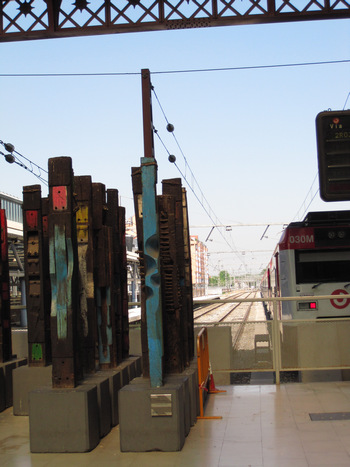
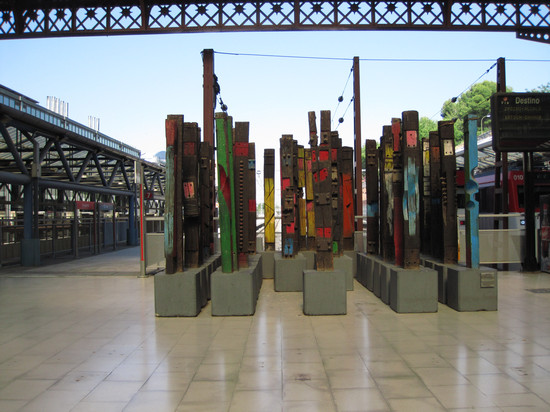
I would like to have taken some close-ups but the installation was on the other side of the gated boarding area.
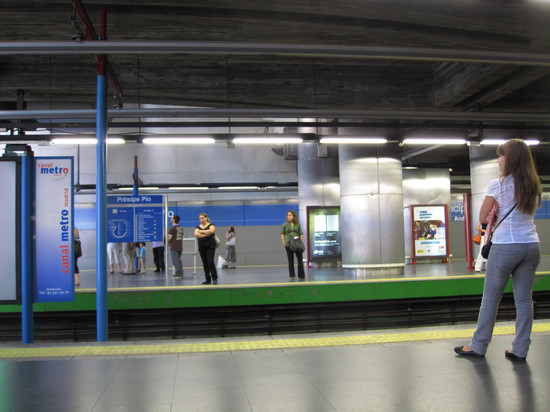
Waiting for the metro in Príncipe Pío (the old "Norte" station).
Being from a small town I seldom get the opportunity to ride an urban metro. What is tedium for most is interesting to me and I always enjoy watching the people on the platforms and in the cars.

On the way to Aravaca.
I took this shot to show the nice pedestrian bridge. I am sure this is just one of many. Madrid has an extensive network of high speed surface roads, most of which slice through one barrio or another.
Aravaca is a barrio of the city of Madrid, in the Moncloa district. It is 9 kilometres (5.5 miles) from the city centre, on the other side of Casa de Campo park. The population of the barrio is 29,547 (January 2006), divided between three areas: Aravaca (23,145), Valdemarín (4,000) and El Plantío (2,469)
During the Spanish Civil War, Aravaca was on the front line for three years in the Siege of Madrid (1936-39). One may still find military bunkers used by Franco's attacking troops in the parks and woods. The old town was completely devastated and was rebuilt in the forties. Dating from this years are the parish church and some houses in Baja de la Iglesia street, all designed in the old Castilian style.
Source: WikiPedia
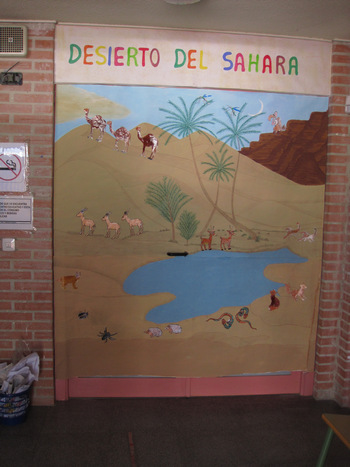
Some decorations in the Rosa Luxemburgo elementary school (Aravaca).
When we arrived, Ana was not quite finished up (what school teacher ever is??!!) so I amused myself by taking some pictures around the school, including these two murals. Nice...

We decided to use the time to get a bit of refreshment so we went across the street to a small shopping area where a little bar was conveniently located. Here, Jeff ordered us a tasty snack.
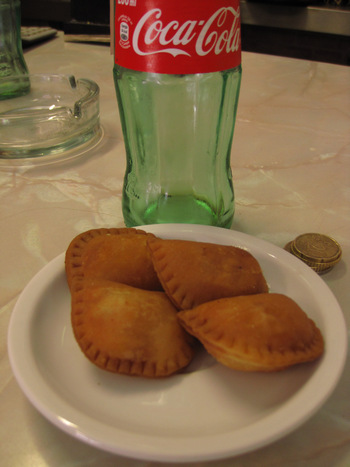
The aperitivo (little " empanadillas") at the bar. Typically, when you order a beer or soda, they give you a small amount of food as well.
These had tuna and goat cheese in them. Too me, this sounded aweful! But, they were quite delish and unlike anything I had had before. This is going to be one great eating safari!
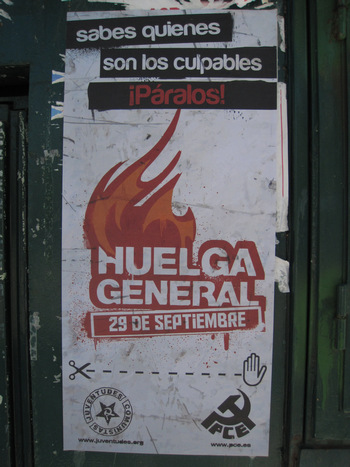
Poster announcing the upcoming (29 Sept) general strike.
I know very little Spanish but when I saw this poster placed on a kiosk near the schoool the word "huelga" jumped out at me. It took me back to the late 60s and early 70s when Ceasar Chavez was organizing migrant farm workers in an effort to get better wages as well as living and working conditions.
Ana had now finished up for the day and we were all ready for something substantial to eat. She and Jeff had a pow-wow about where to eat and soon we were on our way to Restaurante Tú mismo (Yourself), Heron City in Las Rozas de Madrid in seach of more tasty victuals.
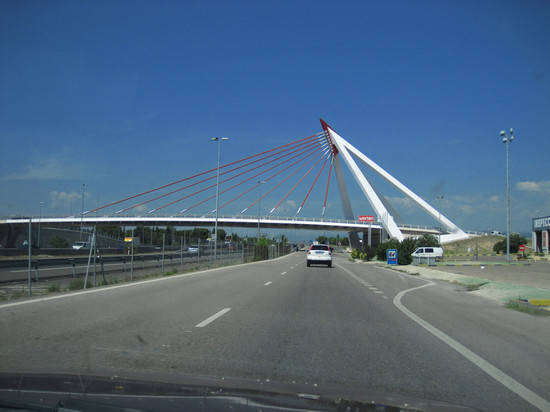
The Puerta de las Rozas bridge over the A-6 (La Coruña Highway): note the cable-stayed construction
What a fab bridge! Check out the photos at urbanscraper.blogspot.com.
Las Rozas de Madrid is about 10-12 miles northwest of Madrid. It is a bedroom community for Madrid and there has been much commercial and residential development there over the last 10-15 years. The population more than doubled between 1991 and 2005 (from 35,137 to 76,246 inhabitants).
Heron City is quite the place. I would describe this place as an open air mall/retail amusement park. But, I will let the developer tell you all about it.
Heron City is a brand of destination centres incorporating both leisure and retail operators in one location. Focusing on being “Always Entertaining”, it includes the various facets of leisure, retail and free time.
The Heron City concept was the first branded chain of leisure and entertainment centres to be developed in Europe. Each Heron City has been designed not just to incorporate the flamboyancy of Hollywood, but to capture the essence of European cultures and tastes in an environment which provides something for everybody.
Within the Heron City family, each Centre is a destination in its own right, with a unique and distinct personality that reflects its locality. Changing its character by day and at night, each Heron City becomes a focal point for the community within its proximity, attracting a total of over 25.6 million people per year.
Source: Heron City
Heron City Las Rozas has become a focal point for the many towns in its vicinity including the inhabitants of Central Madrid. Maturing as a popular destination for families and adults, it encapsulates the charm of a local town square with streets and plenty of daily activity. The Centre is also proud to present one of Europe’s most sophisticated light and water shows, which has been awarded on an international scale. Heron City Las Rozas has been open since 1999 and has become one of Greater Madrid’s most popular places to spend one’s free time. Las Rozas is one of Spain’s fastest growing towns with a population of over 76,200 people. Together with its growing population and affluence, it is also home to approximately 60 companies with 14,000 employees in the adjoining business park to Heron City. The Centre is very well positioned to benefit from the changes and further developments taking place.
Source: Heron City Madrid
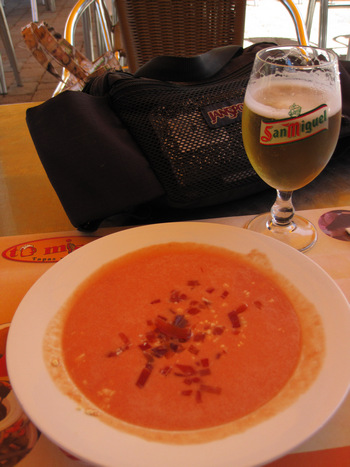
Lunch! Salmorejo, bread, huevos rotos ("broken eggs"..that is, scrambled with fr. fries and pretty much whatever else you want to add...here, peppers), and chopitos (fried cuttlefish)
After looking over the menu and Jeff and Ana explaining the various dishes to me, I settled on the Salmorejo. It was creamy and smooth with the ham and egg giving it some nice texture.
Salmorejo is a cream consisting of tomato and bread, originating in Córdoba (Andalusia) in the south of Spain. It is made from tomatoes, bread, oil, garlic and vinegar. Normally, the tomatoes are skinned and then puréed with the other ingredients. The soup is served cold and garnished with diced Spanish Serrano ham and diced hard-boiled eggs.
It has a pink-orange appearance like gazpacho, but salmorejo is dramatically thicker because it includes more bread. In Andalusia it is known by several other names, including ardoria. Several variations exist in Andalucia; the following recipe is representative of the type of salmorejo served in any bar or home in Seville.
Source: WikiPedia
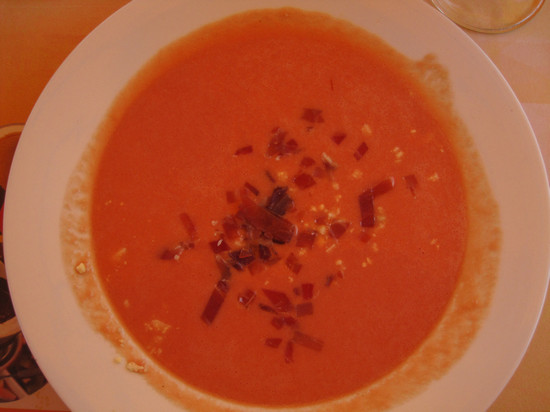
This photo does not do the Salmorejo justice. Not only is it out of focus, the color is off because we were sitting under a yellow umbrella. This caused havoc with the white balance!
The strips are thinly cut jamon and you can see the specks of yellow which is the egg.
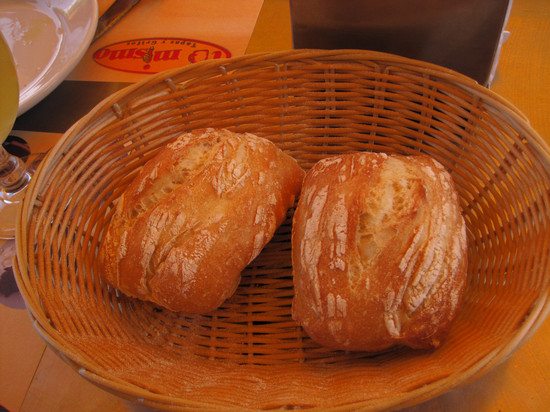
Jeff had mentioned the fact that there were many bakeries just about everywhere and there was always fresh bread. This was the first of many fine specimens I was to see on this trip.
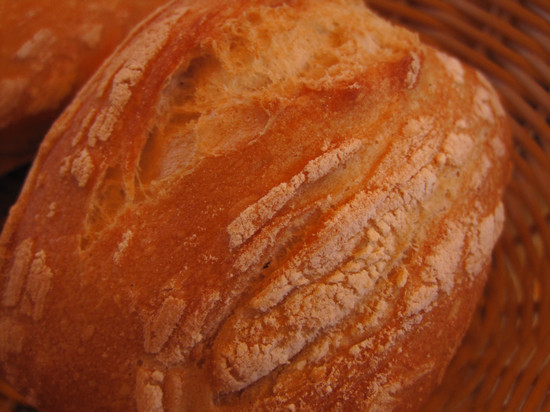
Yummy. I used a chunk to wipe my bowl of Salmorejo completely clean. The waiter got a kick out of that.
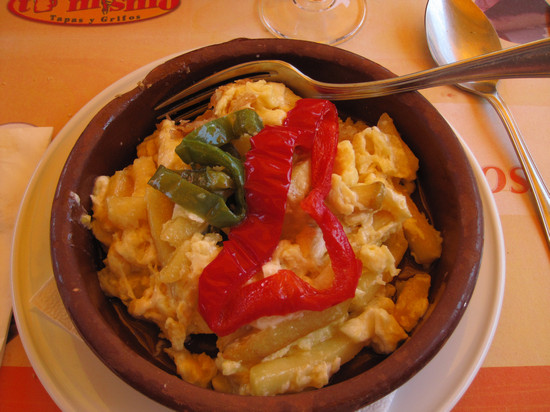
This is Jeff's order of huevos rotos/broken eggs. Jeff shared a bite with me - tasty!
Jeff also ordered a side of Russian salad which is a conglomeration of eggs, potatoes, peas, carrots, peppers, white asparagus, tuna, green pitted olives, and mayonnaise.
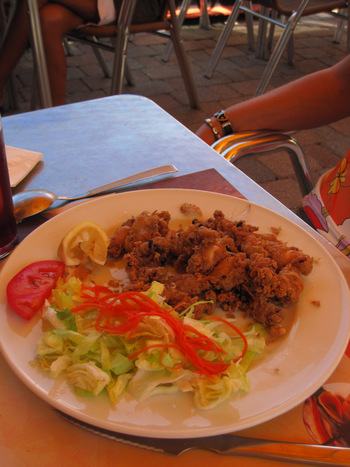
Ana ordered the chopitos (fried cuttlefish). I think Ana also orderd a side dish as well but now I cannot remember. Imagine that...
After our nice lunch we drove up to Segovia - home for Ana, Ani and Jeff. When we arrived at their apartment I laid down for a rest and Jeff and Ana went to the grandparents to pick up Ani. About and hour later Jeff got back to retrieve me and we walked up the block to Jardincillos de san Roque (St. Roque Flower Gardens) park where Ana and the darling Ani were waiting for us.
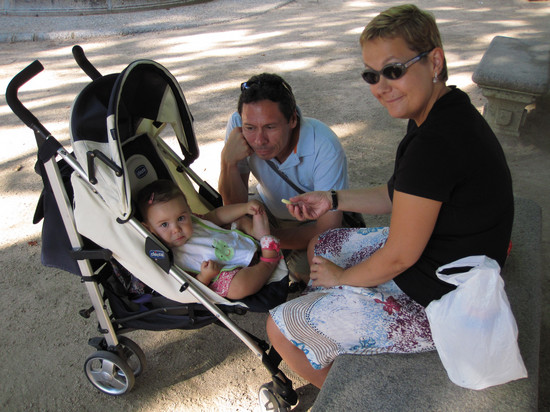
The little family (from left to right, Ani, Jeff and Ana).
So, here is mi familia for the next 10 days. I have to say, it was an interesting and enjoyable experience.
Now we started what was to become an almost nightly ritual, strolling down the wide pedestrian Avenue de Fernández Ladreda to the magnificent Acueducto de Segovia.
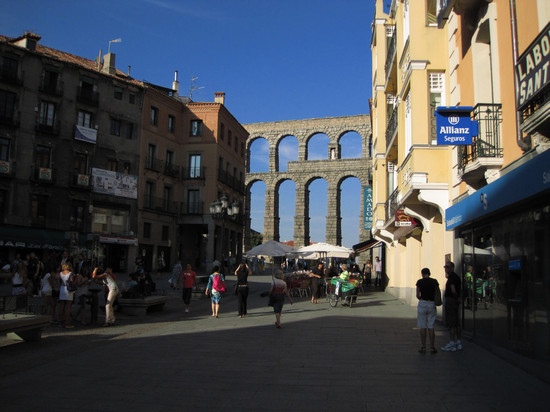
My first glimpse of the Roman Aqueduct. I must have looked at hundreds of photos and visited dozens of web pages related to this structure in the last year. But to see and touch the real thing was pretty amazing. It is still hard for me to believe it is 2000 years old!
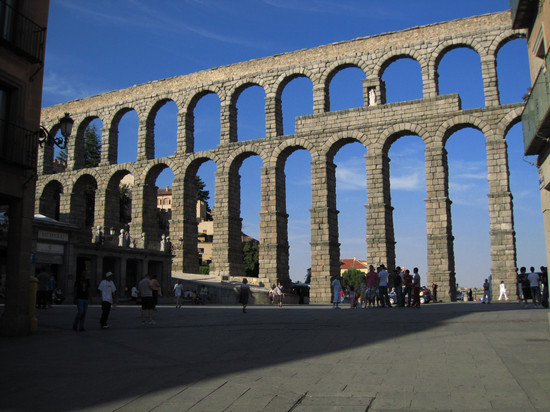
This shot shows the area on the second tier where there once was an inscription. Now it stands blank, kept company only by a statue of the Virgin Mary.
Maybe it said something like "This water brought to you through the might, power and majesty of the Roman Empire". Hey! Who knows??
The small section of wall in the second tier of the aqueduct over the center of the bridge was initially meant to carry an inscription and statues, possibly of Hercules, the legendary founder of Segovia. The bronze letters have long since been removed, and the only thing left are the holes that were used to attach the letters to the wall.
Source: www.romanaqueducts.info
The Aqueduct of Segovia (or more precisely, the aqueduct bridge) is a Roman aqueduct and one of the most significant and best-preserved ancient monuments left on the Iberian Peninsula. It is the foremost symbol of Segovia, as evidenced by its presence on the city's coat of arms.
As the aqueduct lacks a legible inscription (one was apparently located in the structure's attic, or top portion), the date of construction cannot be definitively determined. Researchers have placed it between the second half of the 1st Century CE and the early years of the 2nd Century—during the reign of either Emperor Vespasian or Nerva. The beginnings of Segovia itself are likewise not definitively known. Vacceos are known to have populated the area before the Romans conquered the city. Roman troops sent to control the area, which fell within the jurisdiction of the Roman provincial court (Latin conventus iuridici, Spanish convento jurídico) located in Clunia, stayed behind to settle there.
Source: WikiPedia
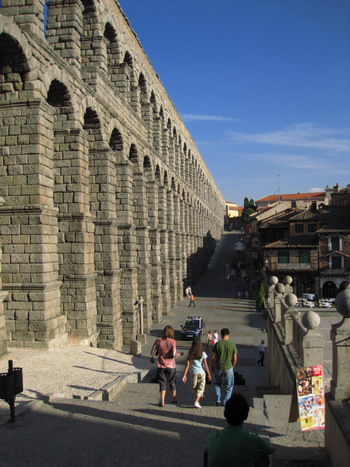
Looking down on Plaza del Azoguejo the grand staircase which leads from the base of the aqueduct to the top and making it an up close and personal, and, indeed, a hands on experience.
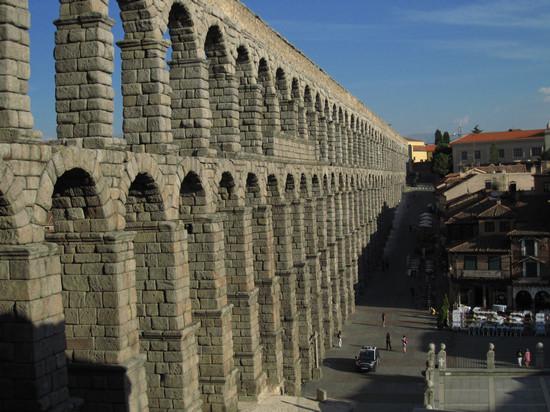
The aqueduct and supporting bridge was originally 9 miles long and channelled water from the Rio Frio to its then terminus, The Alcazar. What remains today is 2,500 feet long and 100 feet high and has 118 arches. The water house, used to help clear sediments from the water also still stands.
It was erected dry, (no mortar) using 20,000 granite blocks. It is still capable of carrying water to this day.
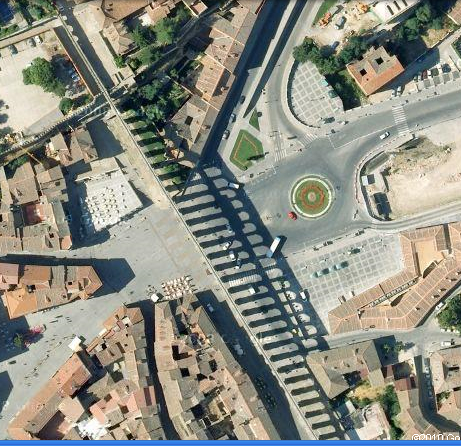
Here is an interesting view of the aqueduct. Shot from directly overhead, the aqueduct is seen only as a thin grey line while the shadow dominates the Plaza.
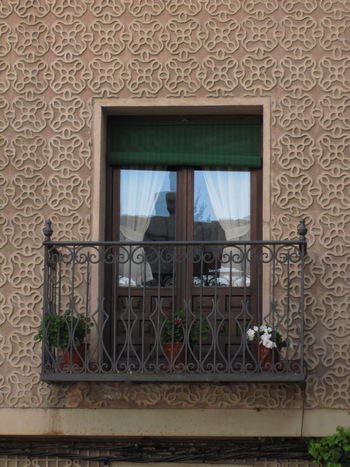
Note the "Esgrafiado" decoration around the window.
This shot was taken near the top of the grand staircase. Jeff and Ana pointed out more of the "Esgrafiado" on this and other walks we took.
The graffito is a decorative technique that involves making incisions on the body of the object or wall, on the surface, so as to expose the bottom layer, which is of another color. Usually use templates for repeating geometric got. The graffito is applied on the plaster of a wall, on objects of pottery and in the Middle Ages on manuscripts in the illustrations in gold.
The term comes from Italian sgraffiare, ie, scoring or scraping with a special tool called graphite.Source: WikiPedia - Google Translation
I continued my way up the staircase taking in the ever changing view.
Everything was perfect that evening. The weather was warm and pleasant and the views of the aqueduct and the surrounding area were gorgeous.
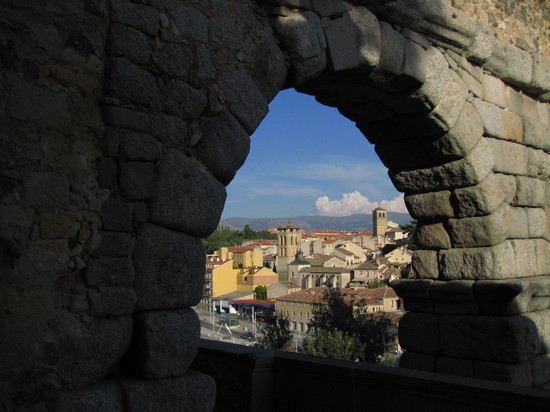
Here, framed through one of the upper arches of the aqueduct we see the churches of San Justo (L) and El Salvador (R). If you look at the original of this photo you will see 4 Stork nests on top of the roof. Jeff told me that I had just missed seeing them as they had already migrated to the overwintering areas.
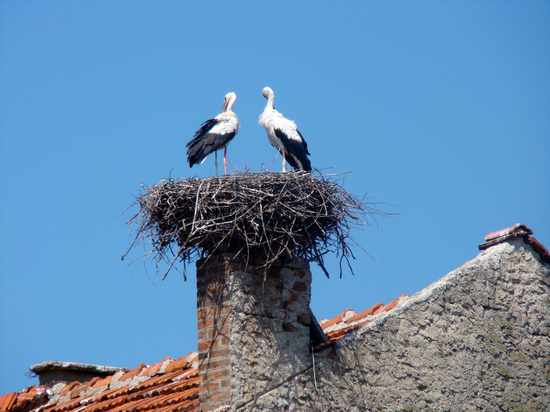
Photo source: WikiPedia
In Segovia and many towns throughout central and southern Spain, no one can ignore perhaps the largest backyard birds in the world--white storks. With six-foot, black-and-white wingspreads and candy-red legs and dagger bills, few birds seem as impressive, and at times awkward, perched on a rooftop.
Over the centuries white storks adopted human towns as nesting habitats, as long as prime feeding areas--pastures, wetlands, fallow fields--sat nearby. Although people valued them as good luck symbols in Spain and legendary baby-deliverers in Germany and other countries to the north, the birds seem too busy raising their own young to concern themselves with human affairs. They cram food into their chicks' bills high above the fray, in bulky stick nests stacked and woven atop terra-cotta rooftops and towers.Source: Wild Spain
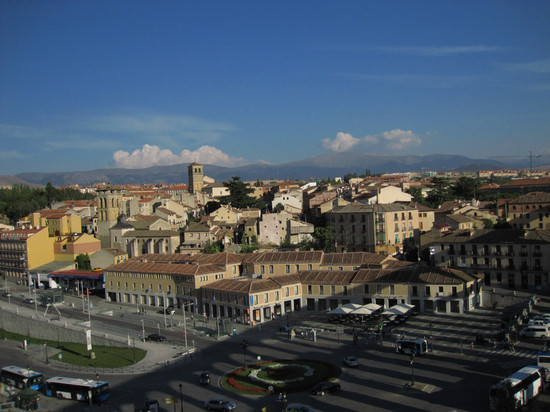
Looking down on the north side of the plaza from the staircase. The roadway ascending to the left was recently rebuilt - complete with underground parking area.
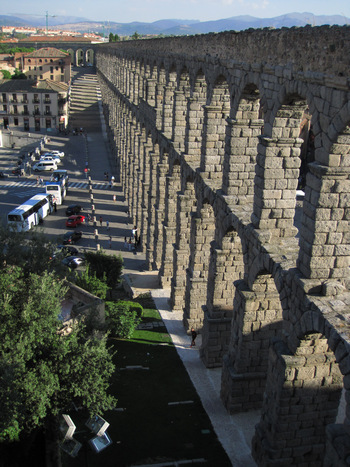
At the far end the aqueduct makes a turn to the left. At this point it loses elevation rapidly and soon is only a few feet above the ground.
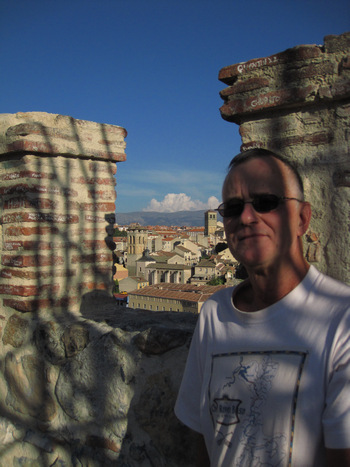
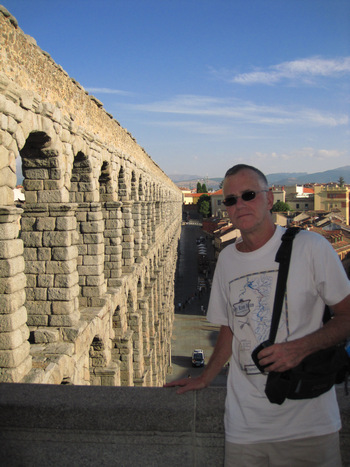
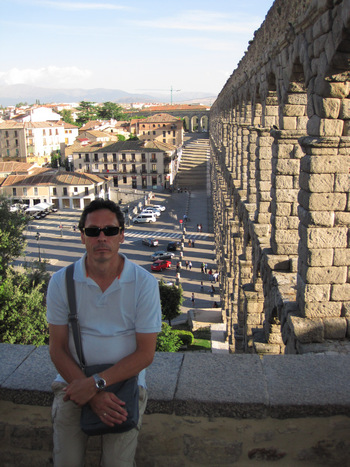
Professor Bruner - my faithful companion and tour guide.
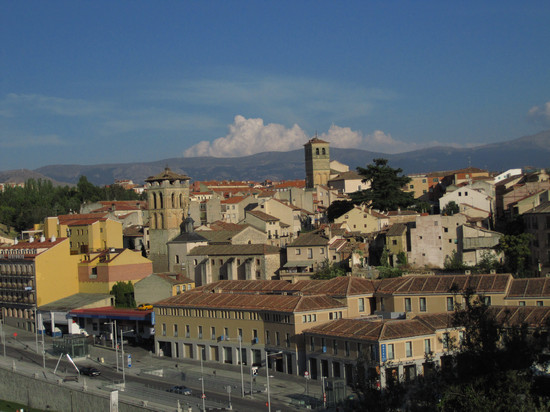
It was difficult to stop taking pictures!!!
My picture taking urges satisfied, we continued on our walk. I vaguely remember the route but here is my attempt to recreate it:
`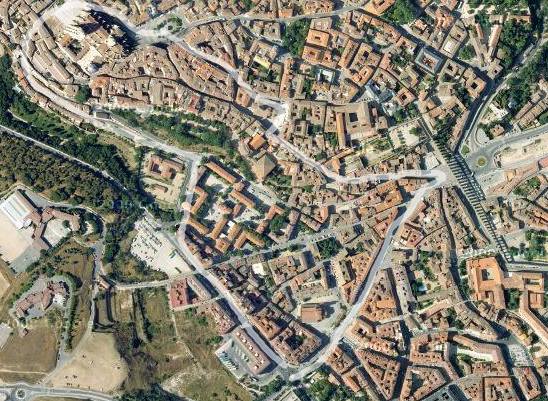
As we walked we passed 1000 year old buildings as well as lots of shops and restaurants. The area adjacent to the Aqueduct, Plaza Mayor and Cathedral is heavily visited by tourists and there are lots of opportunities to have average-to-great meals, pick up souvenirs and get all the latest fashions and the accessories to go with them.
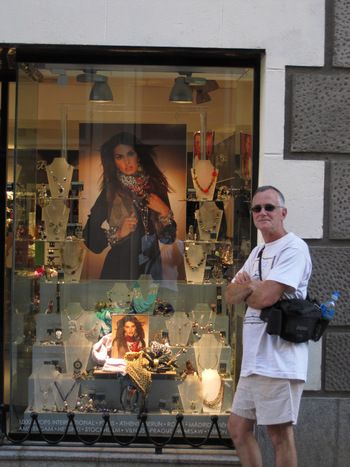
Doing a little shopping on Calle de Cervantes.
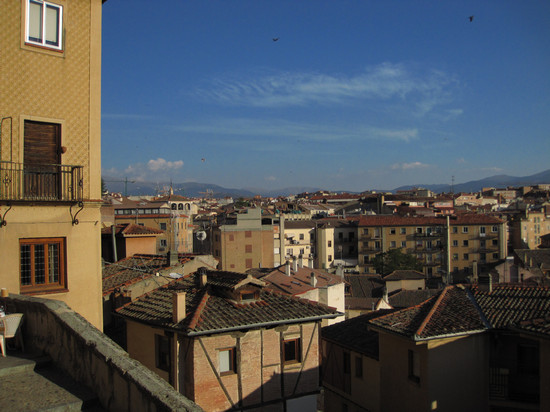
Looking across Segovia at the Sierra de Guadarrama.
The Google Earth image below shows where this shot was taken from as well as the location for the following shots of La Casa de los Picos.
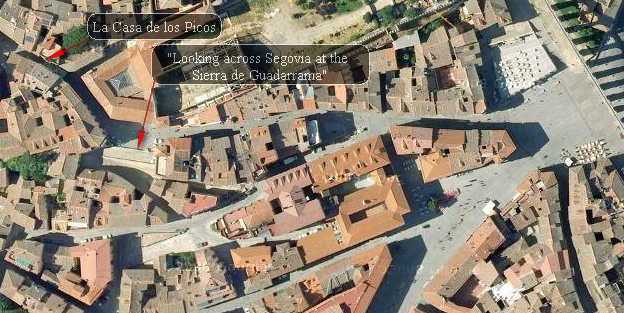
We continued on up Calle de Cervante to La Casa de los Picos and through what used to be Peurta de San Martin (St. Martin's Gate). The gate, which protected the fortified La Casa de los Picos was demolished in 1883.
At this point (no pun intended) the street name changes to Calle de Jaun Bravo.
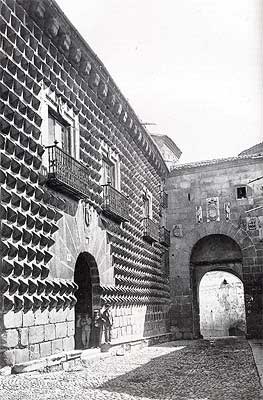
© Universita' Degli Studi Di Bergamo
This old photo is looking through the old Peurta de San Martin towards the aqueduct.
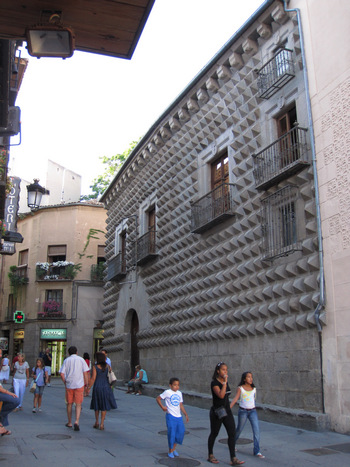
The now gateless Casa de los Picos - literally, house of points.
This is the most famous palace in Segovia, located at Calle de Juan Bravo, 33. Its façade is covered by granite blocks carved into diamond-shapes. This gives an optical effect of light and shadow that is beautiful to see. This type of masonry was common in Italian palaces. There was a portal with a round arch. The house was first owned by Pedro Lopez de Ayala, the Count of Fuensalida, and he built it in the 15th century. The De la Hoz family later owned the house and their coat of arms is displayed above the main portal. The entrance and patio has tiles from Talavera. Today the building is occupied by the School of Applied Arts and Crafts.
Source: Trip Advisor
This home has many legends. One and the most plausible is that claim ownership of the house to a Muslim who was rich.
The new owner was a noble Segovia could not help all people know his property as "the house of the Moor", so he tried to change the name and how to do was to ask advice from a good friend who was a canon of cathedral, which advised him to change something in the front that attracted much attention for people to see differently and so the call otherwise.
The noble ordered that covers the facade of diamond-shaped peaks. From that moment everyone got the call "La Casa de los Picos."Another legend has it under one of these peaks is a treasure. The house has more than 360 peaks.
In another, it tells the story of Don Inigo de la Hoz.
Don Inigo was the owner of the house and had to go to war against Muslims in Sierra Morena, during which Abu-Djavan imprisoned, subjected to a cruel and painful torture.
When he returned home was a widower and had a daughter she called his name Guiomar.The girl grew up and had a suitor who was behind it. One day, the boy got into the house and left her pregnant. His father was furious when he learned a lot, mad with rage and decided to make a pact with the devil so that the facade will be filled with hooks and the boy is torn to climb.
But the boy did not attend that night, sent a servant with a note saying: "The father of the son of Guiomar me, son of Abu-Djhavar, get my revenge, Christian dog." In this way he was avenging his father's torture. Don Inigo thinking even more furious that his blood was mixed with Moorish blood.
She told him what had happened to her confessor, who managed to calm him and convince him that he should not take revenge on another revenge. After exorcising the house, the hooks that were coming were transformed into the next morning in the square stone peaks that can now be seen.
Source: Destylou - Historia
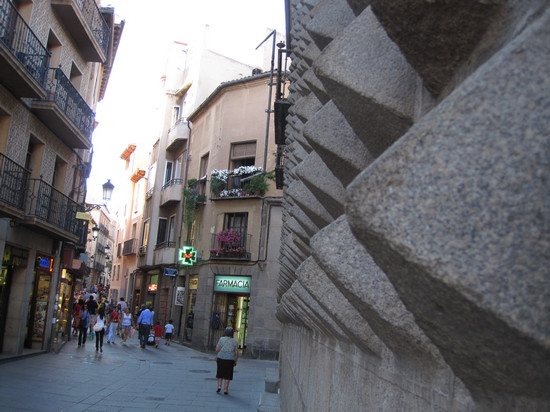
Get the point!!??
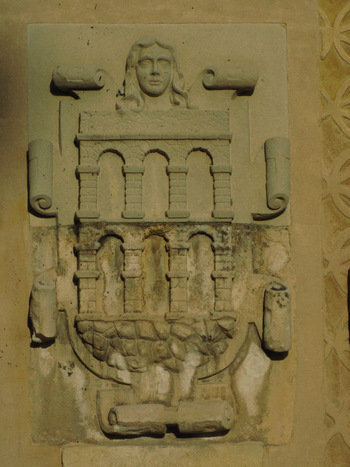
Family crest on one of the buildings.
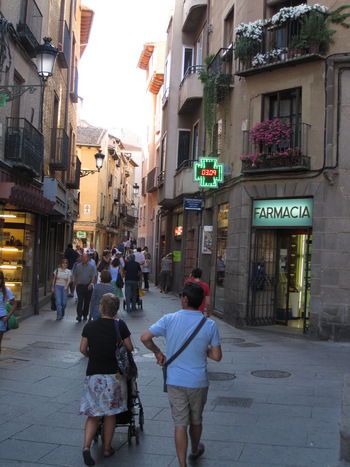
Walking up Calle Real (Royal Way.
Calle Real is the local name for the street. It's officially Calle de Cervantes (until the Casa de los Picos), then Calle de Juan Bravo (until Corpus Christi) and then Calle de Isabel la Catolica.
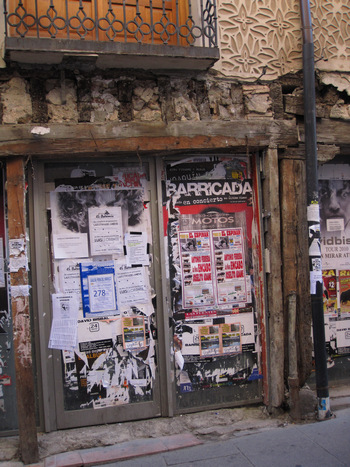
A long abandoned locale.
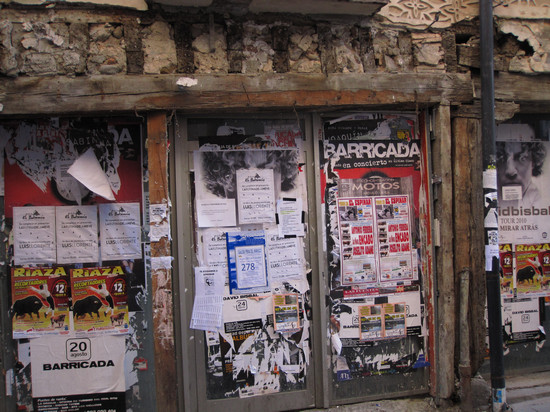
I was quite surprised to see the decrepit and dilapidated store front right in the middle of all the other shops and restaurants.
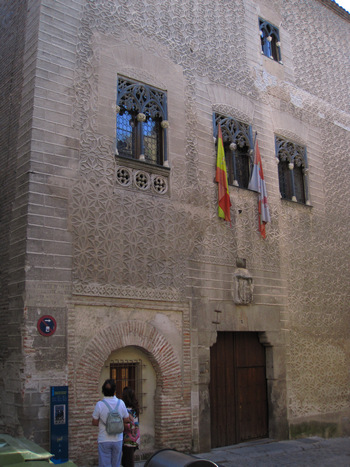
The Palacio de Cascales (Condes de Alpuente).
This building whose name varies depending on the sources (Palacio de Cascales, Aspinall or Conde Alpuente) currently houses the offices of Development.
This building was built in the last third of the fifteenth century by Alonso Cascales, a powerful knight Segovia, stand outside germinated splendid flamboyant Gothic windows carved in slate (two of them, those on the right, added in the early twentieth century ) and the front lintel, which replaced the previous access to, brick and forming a good horseshoe arch, shows how the palace was built on a building in Arabic type.
After the hall we found a space layered small size is made even narrower by the enormous height of the struts forming arcades on three sides. There are seven columns composed of granite drums have the particularity that the two forming angle hold its octagonal spire shield Cascales, its shaft and is also thicker than the rest.
The upper floor was also open in the same three sides by a wooden studs.
Today the courtyard is covered by a glass artist signed by Carlos Muñoz de Pablos and still has the edge of the well, a sign of good economics.
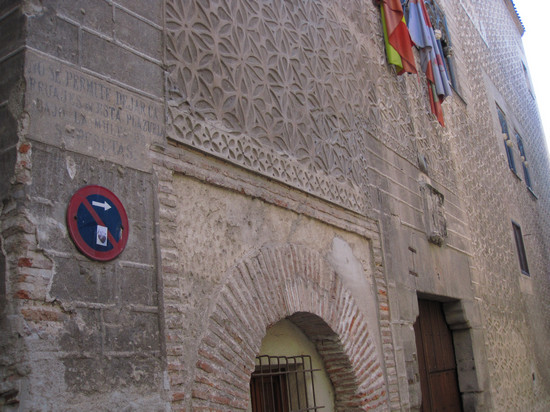
The corner stone sign says "No parking".
The sign says:
"No se permite dejar carruajes en esta plazuela bajo multa de 5 pesetas."
It is not permited to leave carriages in this square under fine of 5 pesetas. / 5 peseta fine for leaving (parking) carriages in this square.
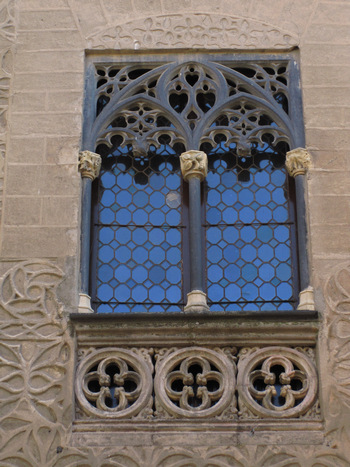
Detail - Slate carved window of the Palacio de Cascales.
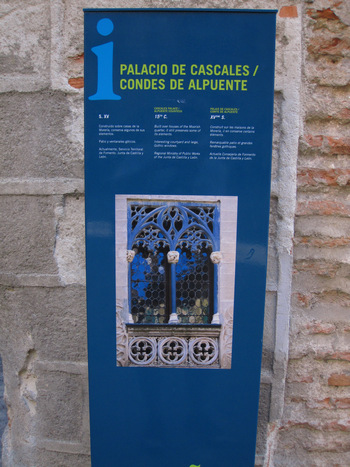
These relatively new informational signs in Spanish, English and French, can be seen all over Segovia.
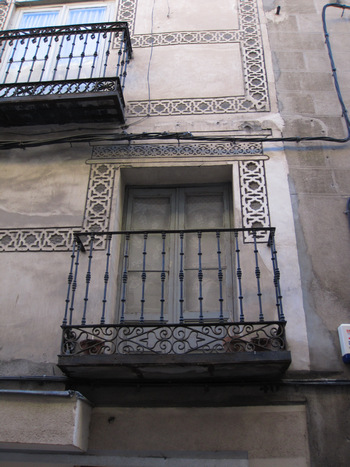
Window and wrought iron balcony as seen along the Calle Real.
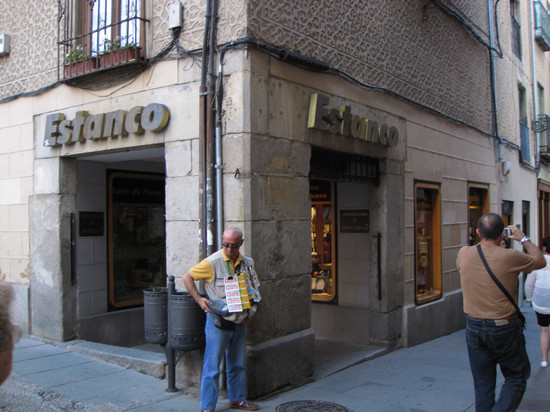
An "Estanco" (tabacconist) and a lottery seller.
I saw these folks selling their tickets just about every place I went in Segovia. The proceeds go to a charity which helps the blind.
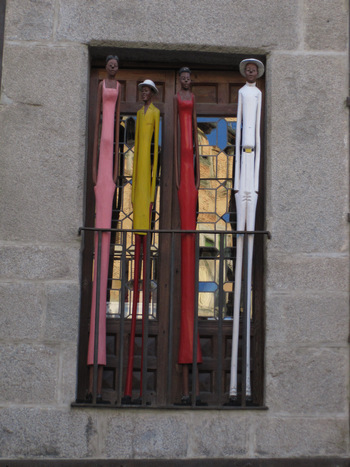
Window of the Casa del Siglo XV that now houses the Galería África.
As we continued our stroll up the street towards the Plaza Mayor we passed the Church of San Martín. Here there is a plaza with statues of various types, the significance of which escaped me. But, they were interesting to see and take pictures of.

One of the "sirenas" (mermaids) who inhabit the Plaza de San Martín
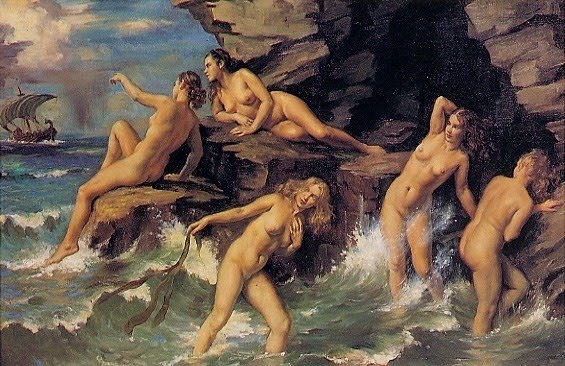
Another interpretation of sirenas: "Las Sirenas" by George Owen Wynne Apperley.
Leaving the Mer-babes behind, we continued our stroll. Now the street name changed again. This time to Calle de Isabel la Catolica. We were now within a stones throw of Plaza Mayor and the fabulous Cathedral.
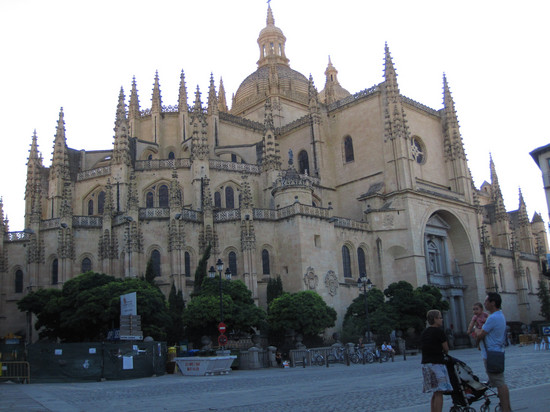
This late evening shot towards the sunlit sky did not make for a very good photo. But, the Cathedral's beauty speaks for itself.
Begun in the 16th century but not finished until 1768, Segovia Cathedral is the last Gothic cathedral to be built in Spain. Fronting the historic Plaza Mayor in Segovia, it stands on the spot where Isabella I was proclaimed Queen of Castile. Affectionately called la dama de las catedrales, Segovia Cathedral has a supremely Gothic exterior combined with a surprisingly bare interior, but contains numerous treasures.
Begun in 1525, the construction of Segovia Cathedral was ordered by Charles V to replace an earlier cathedral near the Alcázar, which had been destroyed during the War of the Comuneros, a revolt against that king.
The designs for the cathedral were drawn up by the leading late-Gothicist Juan Gil de Hontañón but executed by his son Rodrigo, in whose work can be seen a transition from the Gothic to the Renaissance style. The cathedral was finally completed in 1768 and consecrated on July 16 of that year.
Source: Sacred Destinations
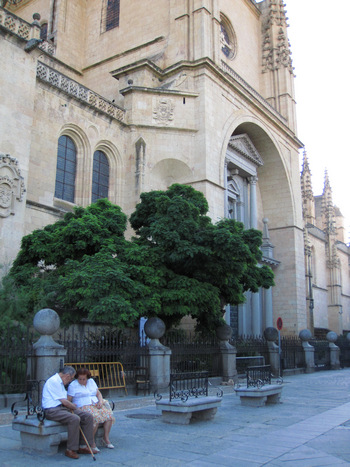
What a great place to relax and enjoy the warm summer breeze.
Note the trees in the background. On inspection I was surprised to find they were heavily pruned Black Locust (Robinia pseudoacacia). It is native to the
Central Appalachians and I was surprised to see it used here as an ornamental.
We continued on our walk and at this point I am not sure exactly what steets we were on.
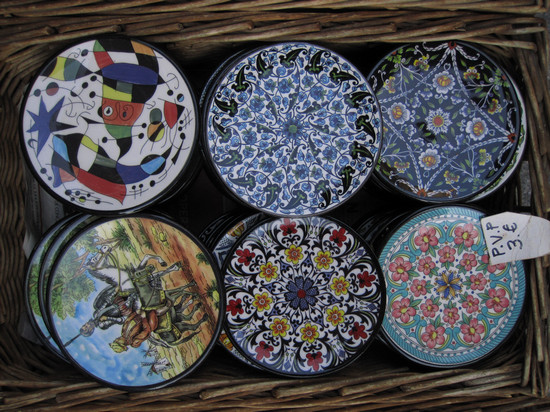
One of the items I had hoped to find and take home were ceramic tile numbers to be used for an address marker. I found them here along with all kinds of interesting ceramic souvenirs.

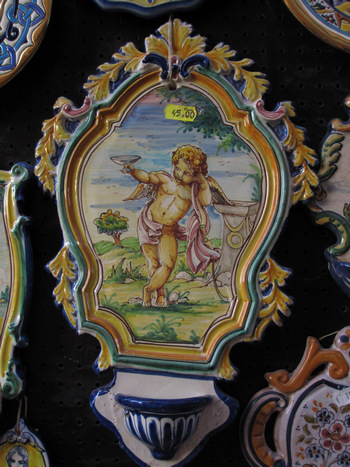
I'll drink to that!
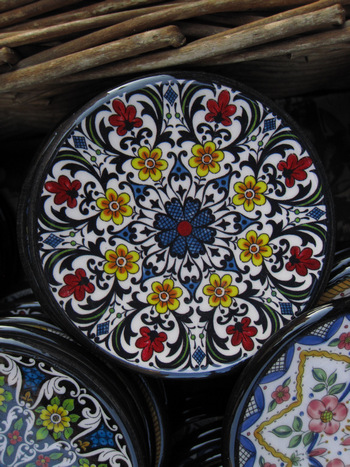
Beautiful! I would like to have brought a suitcase full of these goodies home.
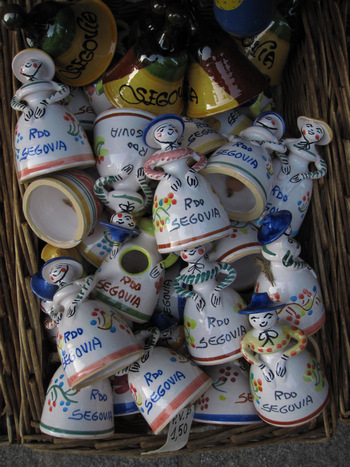
I asked Jeff what the writing on the skirts meant. Here is his explantion:
"Rdo" is the abbreviation for recuerdo, so "Rdo Segovia" = Recuerdo de Segovia or, in plain English, "Souvenir of Segovia".
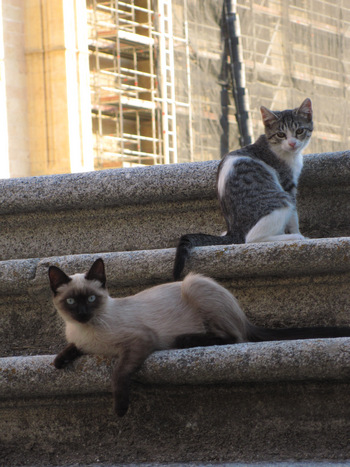
I spotted these kittens lounging on the steps of the Cathedral.

Mini "esgrafiados" as a souvenir.
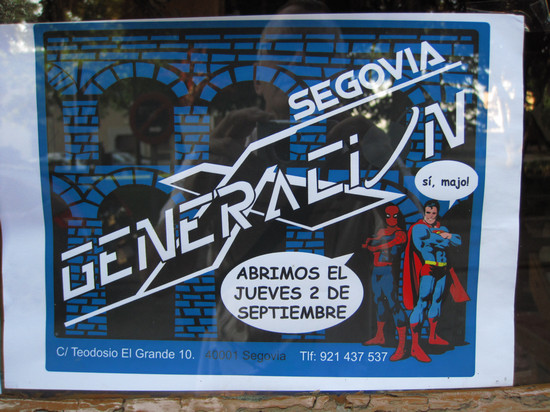
Poster announcing a new bar/club in Segovia.
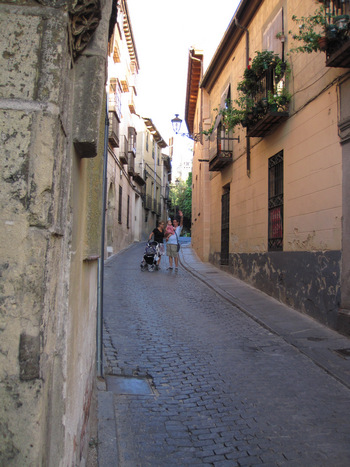
Ana, Ani and Jeff wave while walking down Calle de Daoíz, a typical narrow street in old Segovia.
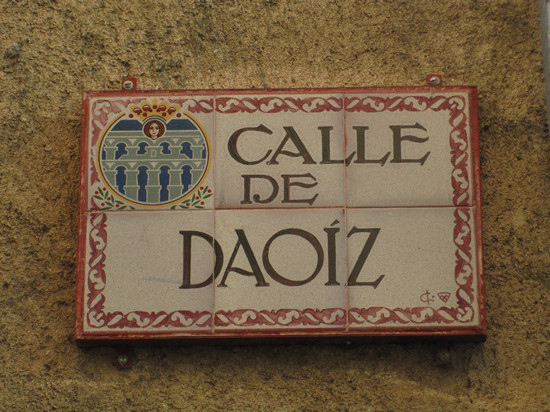
I love these ceramic tile street markers.

This shows the built up layers of plaster used in the technique called "esgrafiados". Engraved plaster.
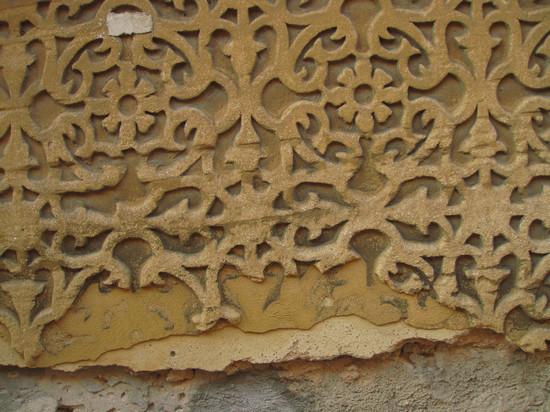
This closer look clearly shows three built up layers on top of the base material used to construct the wall.
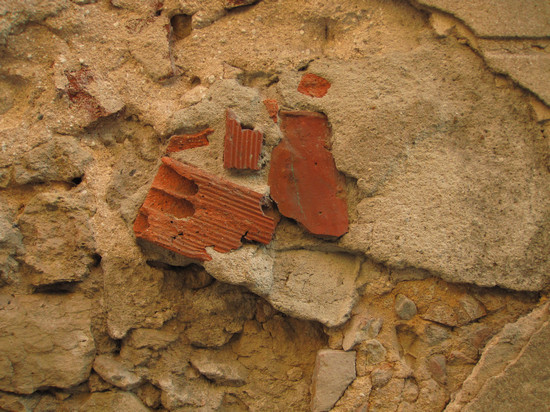
The walls were built with anything on hand. Raw or cut stone, building rubble, and new and used bricks.
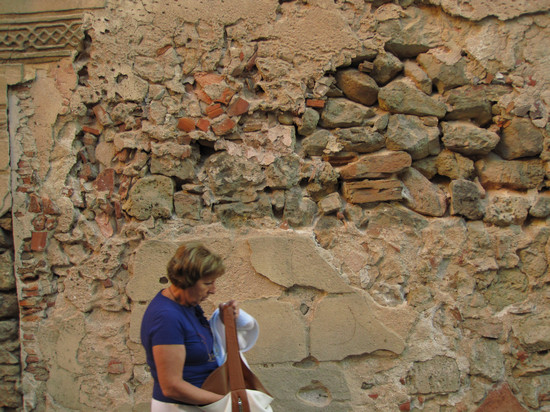
The crumbling remains of the esgrafiados surface can be seen in the upper left corner.

Another look up the winding and narrow Calle de Daoíz.
Now we left the old narrow streets and came out to the old wall which protected Segovia for centuries.
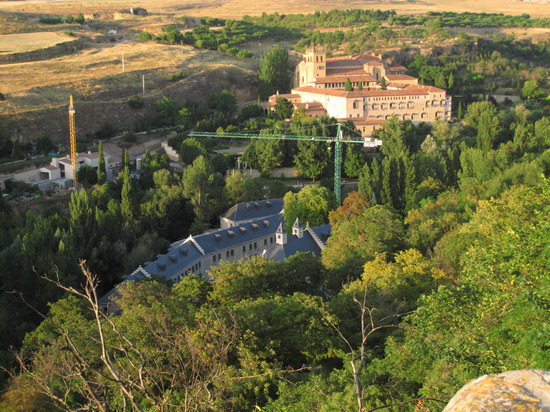
View (from the entrance to the Alcázar) of the Casa de la Moneda (Royal Spanish Mint) and the Monasterio del Parral.
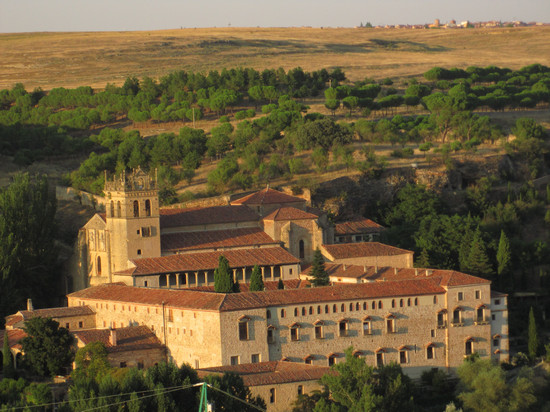
A closer look at the Monasterio del Parral and the somewhat austere and certainly arid countryside.
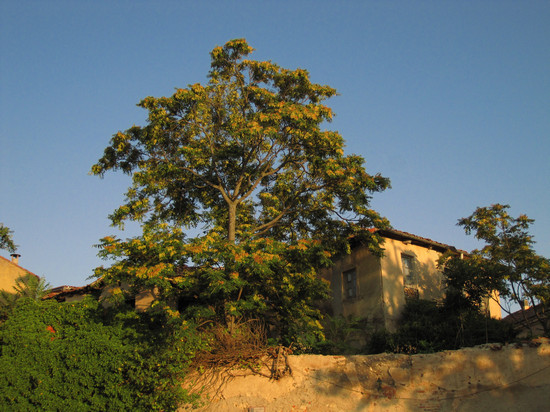
This is a specimen of the Tree of Heaven (Ailanthus altissima). Or, as I usually think of it: "The Tree of Hell". Any time I see one I cringe. Why? Because it is a non-native and agressive invasive species that has taken over many areas where native trees used to thrive.
But, this tree, in this locale, bathed in the golden light of early evening looked gorgeous and stately.
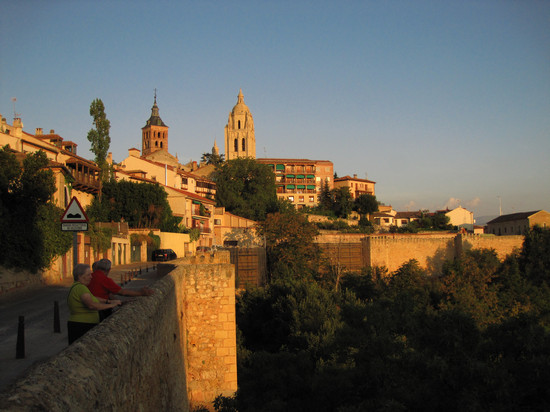
Walking toward the Cathedral along the old city wall.
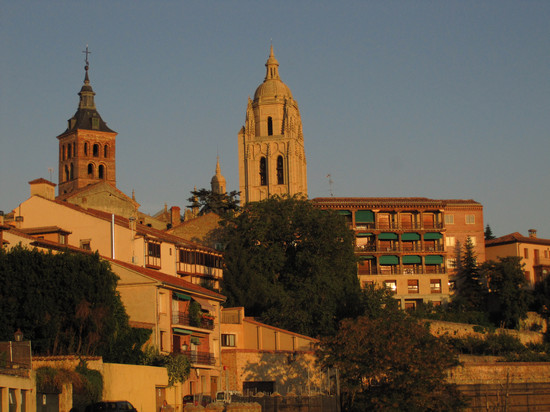
I was captivated by the views of the old buildings and Cathedral glowing in the sunlight. It was like nothing I had ever seen before and I was enthralled by it all.
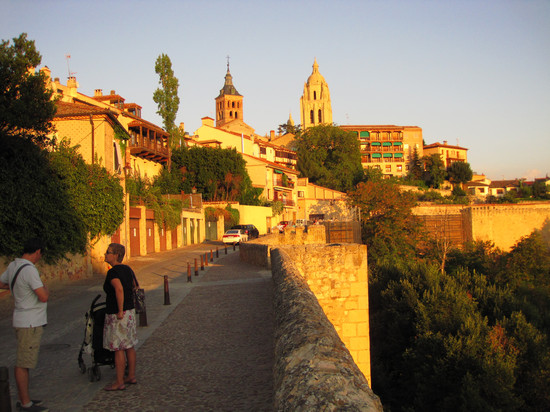
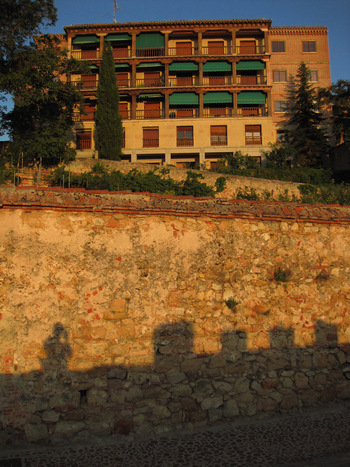
"Me and my shaaaaaaaa-dow!"
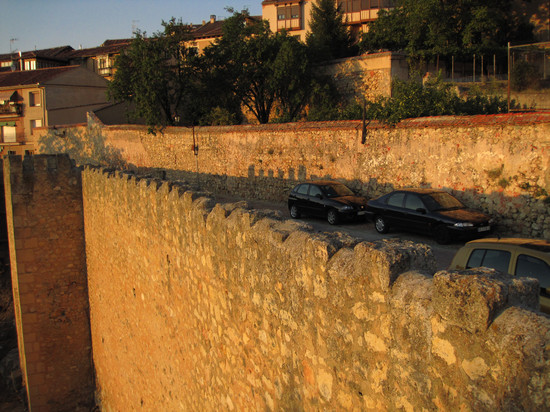
Here you can see the shadow of the dentiled top of the wall.
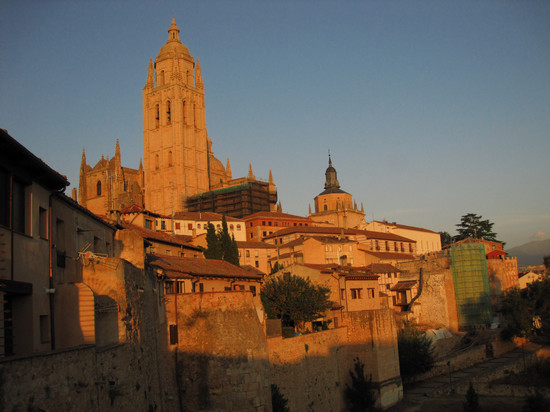
The old city and Cathedral.
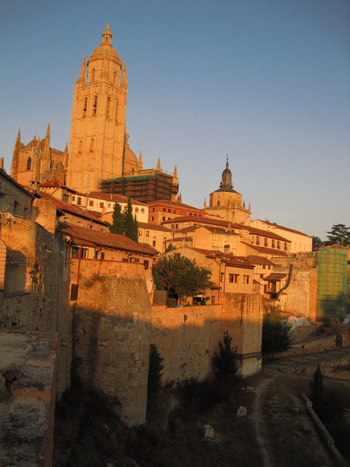
Although little more than the backside of the Cathedral is showing, to me it was gorgeous.
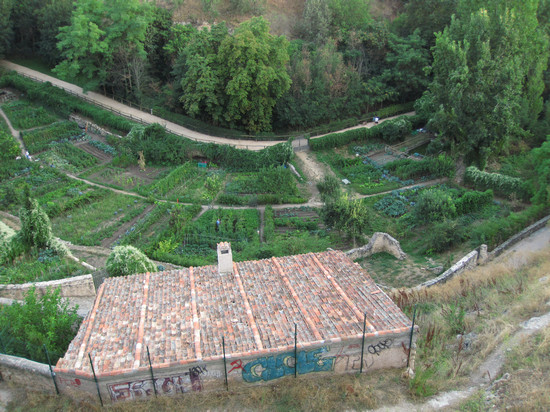
Perched up on the wall we could get a good view of vegetable gardens and Greenway along the Clamores river.
These lush and productive gardens are made possible by water diverted from the river.
Now, we start to descend from our lofty perch along the wall through a section of the old Jewish quarter.
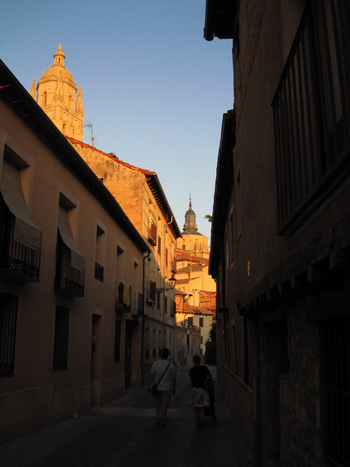
Walking along the Called de San Valentín.
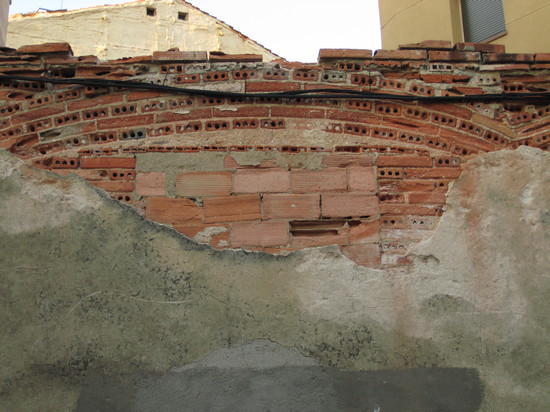
Wall construction. Spanish-style.
This is interesting. It looks to me like the brick arch once supported the roof over a window opening which was then filled and the whole thing then plastered over. I could not tell whether this was unfinished, or so old it was starting to slip into disrepair.
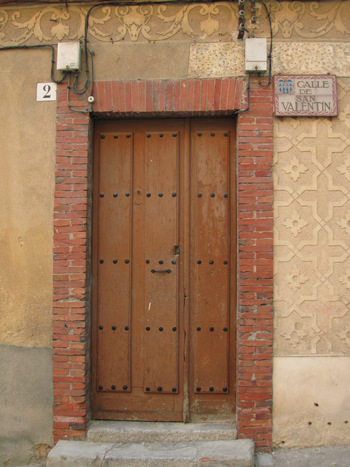
See, I told you it was the Calle de San Valentín.
Interesting doorway. Note the tiled name plate - upper right.
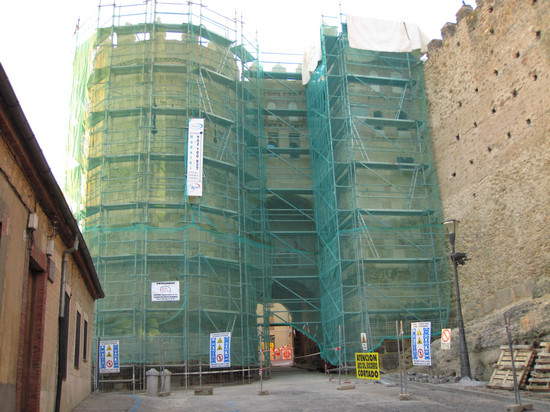
The Puerta de San Andrés (getting a face lift).
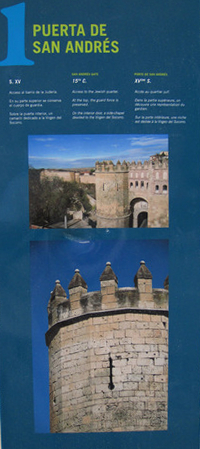
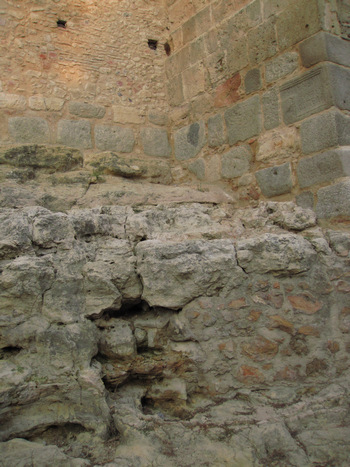
The base of the wall showing bedrock and fill material near Paseo de los Tillos.
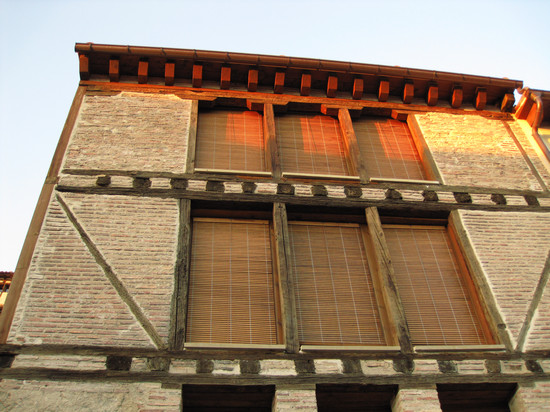
Typical construction style.
Lots of rocks and clay, but not many trees.
By now we had all worked up a pretty good appetite. Unbeknownst to me we were having something special for dinner.
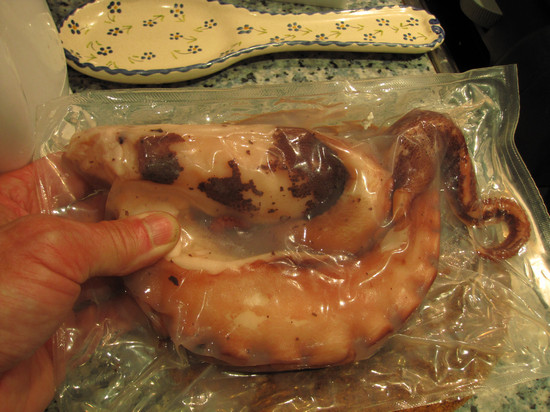
Ready to make supper (octopus leg).
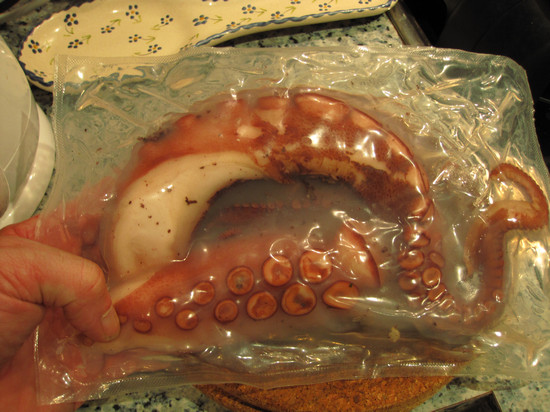
This would be a first for me and I couldn't wait to get my teeth into those suckers!
"Pulpo Gallego" or Galician-Style Octopus is a "tapa" or appetizer served all over Spain today. It is very simple, cooked octopus served with boiled potatoes, olive oil and sweet Spanish paprika. © 2010 About.com
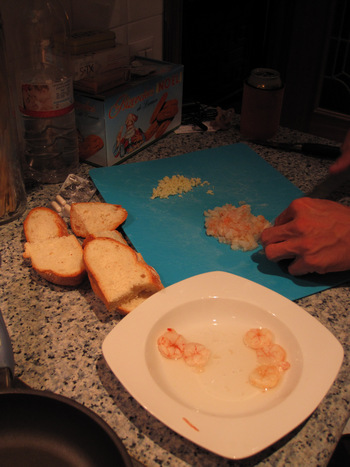
Preparing a spread of garlic, shrimp and surimi ("krab" meat).
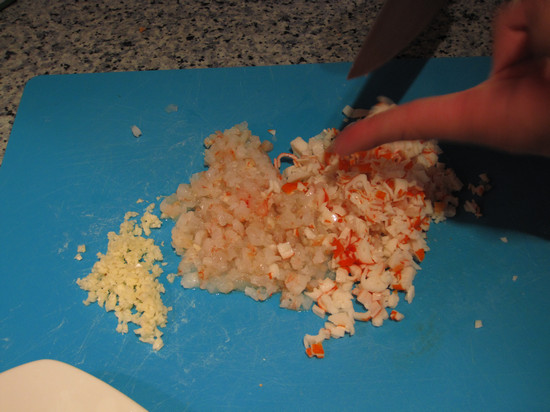
Jeff gets the dicing done...
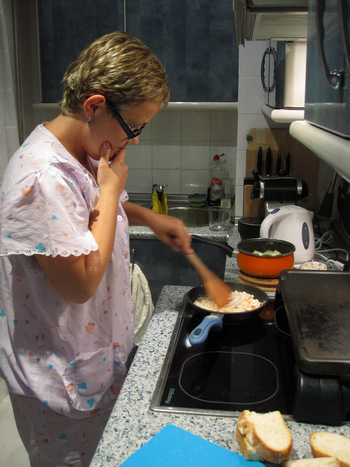
...while Ana cooks it all up.
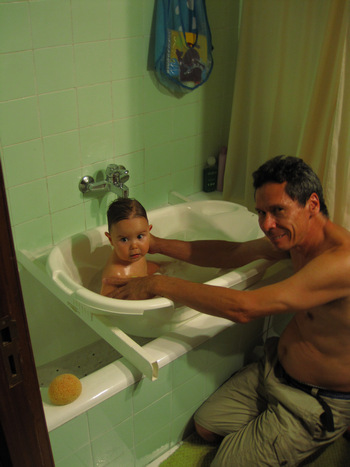
In between dinner prep Ani gets her bath.
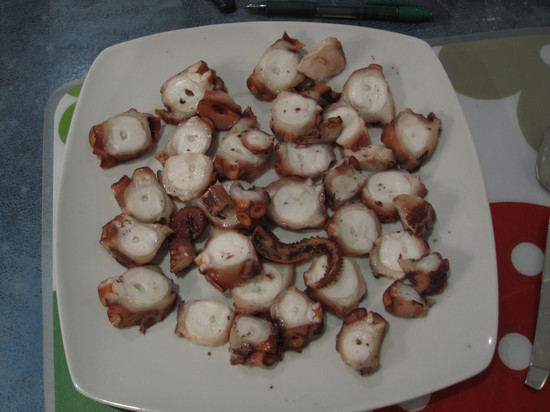
The same octopus leg, sliced.
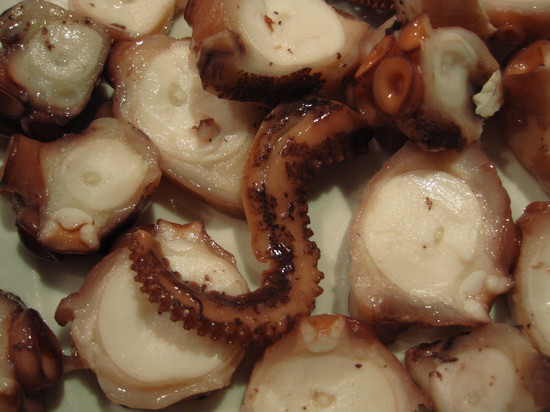
Mmmmmm... does that look good!
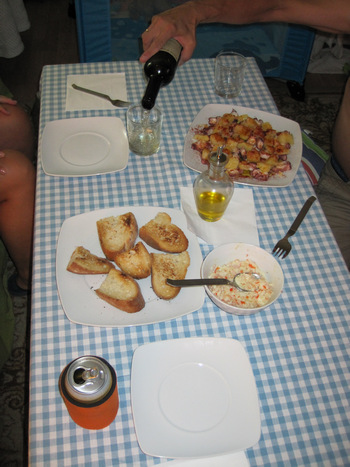
Dinner is served!
Boiled octopus leg with seafood spread and a crusty toast. What a great homecooked meal - Spanish style.
Me lucky guy...
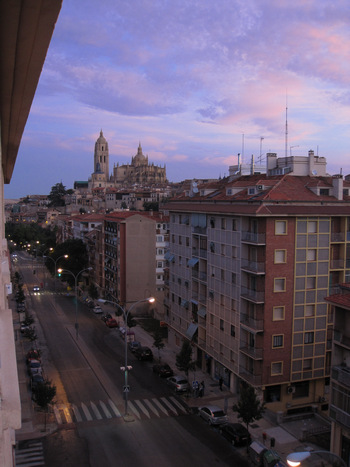
Night falls over the Cathedral.
Final shot of the day - and a long and full day it was. Whew!
Thanks Jeff, Ana and Ani for making my first day in Spain a truly memorable one.
Buenas noches!


